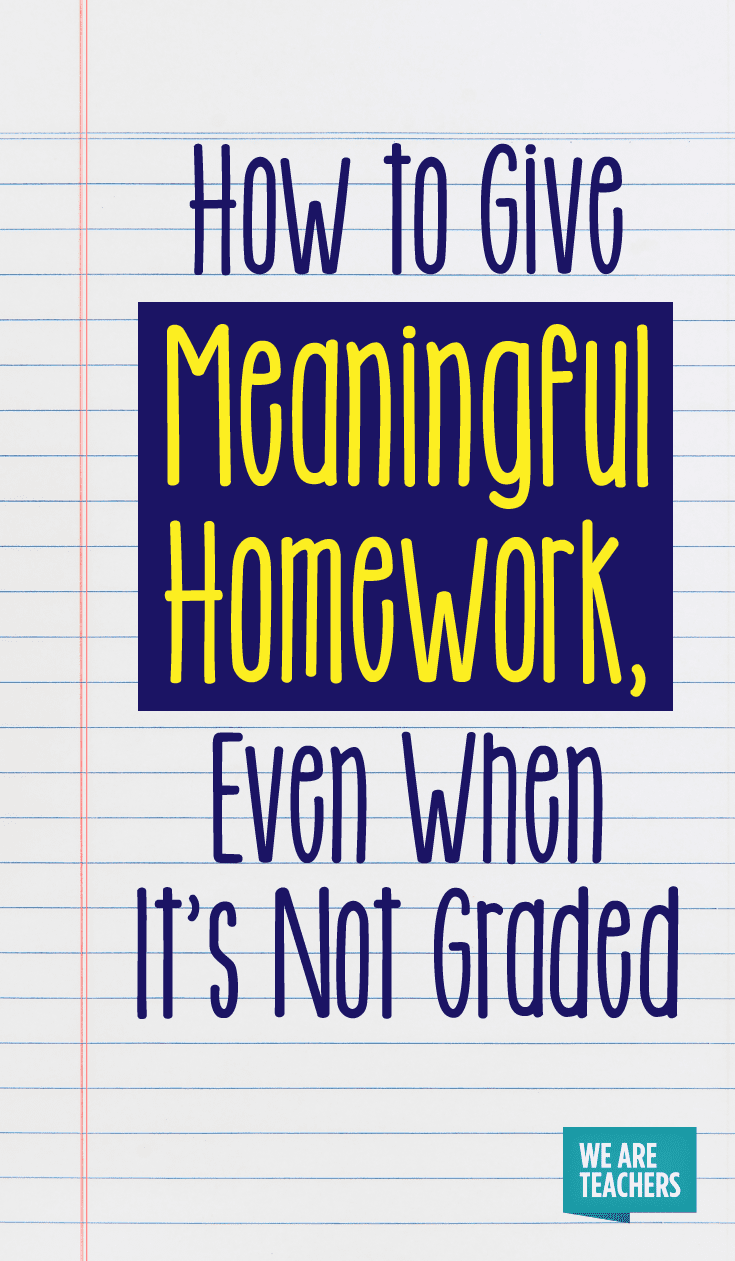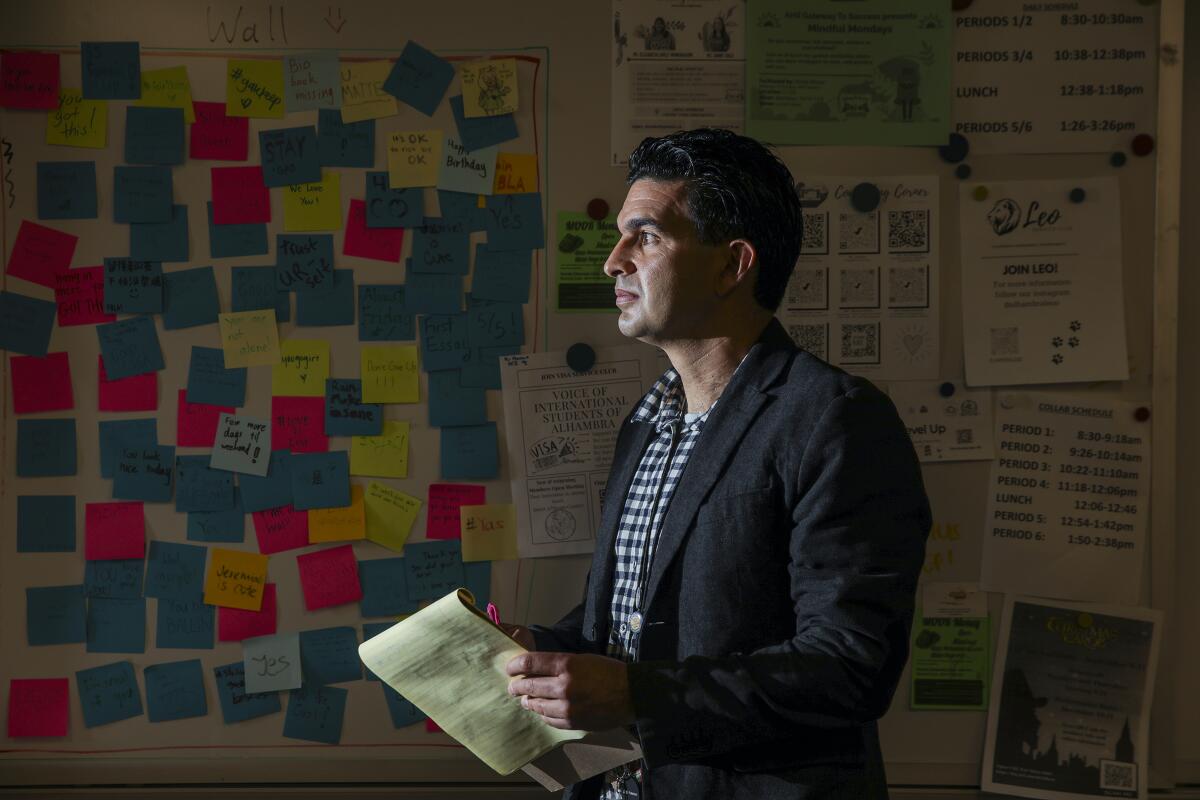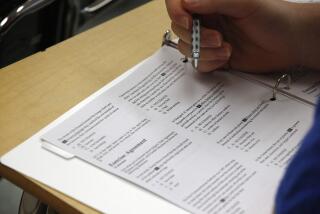The Problem with Grading
- Posted May 19, 2023
- By Lory Hough
- Education Reform
- Student Achievement and Outcomes

My son’s binder was a mess. Loose papers were falling out, others looked like they had been balled up or stepped on, some more than once. The binder itself was bent in one corner. But he was a seventh-grader and to him, it looked just fine.
Unfortunately, his seventh-grade math teacher didn’t agree and deducted points from his grade for being messy. This same teacher also took off points when homework was completed with something other than a pencil or if a student needed a second copy of an assignment. If a student was asked to move their seat during class, she slashed five points. Points were earned back if a parent signed the list of rules, and it was returned in a timely manner.
Being organized and not misbehaving in class are skills students need to figure out, for sure, and I certainly wanted my son to be neater, but factoring these behaviors into grades — especially for middle-schoolers just learning to come into their own — didn’t make sense to me.
And so, when I learned, a few years later, that my son’s high school was rethinking their grading practice, I decided it was time to dig deeper into what Grading for Equity author Joe Feldman, Ed.M.’93, calls “one of the most challenging and emotionally charged conversations in today’s schools.”

Grades Are What?
I started by asking a question that seems simple on the surface: What is a grade?
Feldman, a former teacher and principal, says that on a really basic level, grades are the way teachers calculate and report student performances. Typically, it’s an accumulation of points (0 to 100) with corresponding letters (A through F, minus E). Earn an 89 on a test and your grade is a B+, for example. Believed to date back to 1785, when Yale President Ezra Stiles gave four grades to his seniors ( optimi , second optimi , inferiors , and pejores ), grades have long been a part of our education system in the United States. In fact, Feldman says, grades have become “the main criteria in nearly every decision that schools make about students,” from whether they get promoted to the next class or held back, to which course level a student should be taking, such as college prep, honors, or AP. It’s how many high schools tally GPA and student rank, and one of the main ways that colleges decide who they’ll even consider for admissions.
“Grading is evaluation, putting a value on something,” says Denise Pope, Ed.M.’89, a senior lecturer at Stanford who runs a project called Challenge Success. Pope stresses, however, that grades are not the same as assessment, and to really talk about grading, we have to make the distinction between the two terms.
“Assessment is feedback so that students can learn,” Pope says. “It’s helping them see where they are and helping them move toward a point of greater understanding or mastery. Grading doesn’t always do that, but assessment should.”
When she hosts professional development workshops to help schools rethink their assessment practices, she likes to point out that the Latin root of assessment is assidere , which means to sit beside. Assessment is seeing where a student is with their understanding — what they don’t know, what they do know — and then using that to determine what they need. “Sometimes a grade does that,” Pope says, “but a lot of times students have no idea what that grade means.”
And that’s what seems to be at the heart of the debate about grading, and what rubbed me the wrong way when my son was in that math class: Students, teachers, parents, and college admissions officers have no idea what a letter grade — this thing we are saying is really important in a student’s school life — is really saying. Does an A mean a student has truly mastered that history lesson? Does the C+ mean the student was “sort of” getting the math they were learning, or did it mean they were an ace at math, but just couldn’t keep a neat binder?
What’s the Problem?
The confusion starts with consistency, as in, there is none. At most schools, there’s no consistency about what’s included in a grade or what’s left out, even among teachers teaching the same subject in the same school to students in the same grade at the same level. This creates what is often called “grade fog” — we’re not sure what the grade means because we’re asking that A or that C+ to communicate too much disparate information.
“It’s radically inconsistent from teacher to teacher,” says A.J. Stitch, Ed.M.’12, the founding principal of the Greater Dayton School, a private school in Ohio for kids from low-income backgrounds that doesn’t use traditional grades. At public schools where he has worked in the past, he says “most teachers had different approaches to weighting homework, classwork, quizzes, and tests.”
For example, he says, “a student may demonstrate mastery of content on a test, quiz, and classwork, yet still fails a course because the teacher decides to weigh homework 40%, and the student, for one reason or another, struggles in that regard. Obviously, that’s inequitable, and it illustrates the variation of weighted grade scales and how it impacts a student’s success or failure, regardless of whether they mastered the standards taught in the course. Sadly, I made this mistake myself as a young teacher, and as a principal I’ve seen too many teachers make this mistake, too.”
Jason Merrill, the principal of Melrose High School, where my son currently goes to school, says this is one of the biggest reasons they started looking at their teaching and learning practices, and why they applied to become one of five schools in the multi-year Rethinking Grading Pilot program sponsored by the Massachusetts Department of Elementary and Secondary Education.

“Your son has eight teachers right now that all have their own way to grade. Completely their own,” he says. “The average kid often gives up trying to figure it out. Some teachers count homework, some teachers don’t. Some teachers grade homework, some teachers grade it as completion. Some teachers count large tests for a lot more than others. What we want to do is not have 85 different ways to respond to a fire alarm.”
Feldman says we also don’t want to include non-academics in grades — things like messy binders and not coming to class with a pencil, or the one that is commonly factored in: late work.
“A student who writes an A-quality essay but hands it in late gets her writing downgraded to a B, and the student who writes a B-quality essay turned in by the deadline receives a B. There’s nothing to distinguish those two B grades, although those students have very different levels of content mastery,” he says.
Traditional grading also invites biases, he says, especially around behavior. “When we include a student’s behavior in a grade, we’re imposing on all of our students a narrow idea of what a ‘successful’ student is,” Feldman says, and “you start to misrepresent and warp the accuracy.” For example, a student who participates in discussions and always brings their pencil to class earns five points, but they get a C on the test. Adding the five behavior points lifts that C test grade to something in the low B range. Although students and parents are happy the grade is a B and that the student’s all-important GPA remains intact, this warping can create longer term problems.
“You’re telling the student that they’re at a B level in content, and they’re actually at a C,” Feldman says. “They don’t think there’s a problem, the counselors don’t think there’s a problem, and the student goes to the next grade level and gets crushed by the content. They had no idea that they weren’t prepared for the rigor of that class because they kept getting the message that they were getting B’s.”
It can be especially confusing for parents, says Christopher Beaver, one of the assistant principals at Melrose High. “I knew what my own kids could do skill-based wise, but if I’m a parent and I don’t know what my kids can do because the teachers haven’t laid that out for me on a report card, then I can’t look at a report card and say, ‘See that. My kid is proficient at this skill or my kid is proficient at that skill,’” he says. “I’m going to focus on something like the GPA because that’s all I have. And I’m going to assume, if my kid has a high GPA, that my kid’s skillset is at a proficient level. But that is not always the case.”
As a parent, I was confused earlier this year when my son’s overall grade in a class was low, even though he seemed to get the content. We looked online at the grading portal the district uses and sure enough, he had Bs and As. But then there was that one grade: a 44 on a test he didn’t have enough time to finish. That one low test score brought the whole grade down because of another impossible part of how we grade: averaging.
“We have this ridiculous system of averaging things out,” Pope says, “which doesn’t make any sense because the goal is to get students to learn material. Same with the case against zero, right? Why would you give a kid a zero? A zero is worse than an F.”
The “case against zero” idea is that when using a 0-to-100-point scale in grading, a student should never receive a zero, even if they didn’t turn in an assignment. Sounds odd, given that a zero for not turning in work is how we’ve long operated, but as author Doug Reeves wrote in 2004 in “The Case Against the Zero” in Phi Delta Kappan , “assigning a zero is disproportionate punishment.”
Why? Because mathematically, with a 0-to-100 scale, failing a class is more likely than passing a class. Think about it. Each letter grade is 10 points — an A is 90-100, a B is 80- 89, a C is 70-79, and a D is 60-69 — but the scale’s one failing grade, an F, spans not 10 points, but 60 (0 to 59). The result is that a zero disproportionally pulls down an average and makes it that much harder to pull a grade up significantly. A student with two 85s, for example, is averaging a B. If that student gets a 0 on one assignment, their average drops to 56, an F. Even if the student gets 85s on the next two assignments, their average still only jumps to a 68. So, four Bs and one zero means the student’s averaged overall grade is a D+.
This averaging especially penalizes students who start out a semester slower with lower grades. Even if they figure out the material and fully master content later, averaging won’t necessarily reflect what they truly know. In his book, Feldman gives an example of a student who, coming into ninth grade, had never learned to write a persuasive essay. The ninth-grade teacher gives an assignment early in September, revealing this student’s writing inexperience.
“The essay gets a D-. But it’s early in September, and you, as the teacher, provide instruction and guided practice with feedback,” Feldman writes. The student’s writing improves, and their grade goes up with each new assignment. The student eventually learns how to write an amazing persuasive essay. They are doing A work. However, when the grades are averaged, that early D- drags down the overall grade and though the student mastered persuasive writing, their A drops to a B-.
Add Stress to the Mix
Beyond the problems with how we grade or what a grade means, Robin Loewald, Ed.M.’19, an English teacher at Melrose High, also worries about the effect grades have on student mindset, especially for middle- and high-schoolers.
“Grading in general is tough because of the expectations for students with college applications,” she says. “There tends to be a lot of stress around grades and the minute difference between a 93 and 94. In truth, it’s hard to really delineate the difference between those two numbers in terms of student understanding and mastery of the subject.”
Pope focuses her work extensively on the stress students take on trying to chase “good” grades and the extrinsic motivation — driven by external rewards — that takes over. In an op-ed she co-authored in February for The Hechinger Report about the furor over ChatGPT, she wrote that instead of asking how to stop students from cheating using bot programs, we should instead be asking “why” students are cheating in the first place. Chasing those good grades is part of that “why.”
“We have this real system of you need to get the grades and the test scores in order to please your parents, go to college, get the merit scholarship, get a good job — whatever it is,” she says. “There’s this extrinsic motivation that’s tied to grades, which adds to student stress, and in some cases can lead to really unhealthy practices like perfectionism or great anxiety, paralysis. And it could also really turn kids off. ‘Well, I got a C so I’m bad at math. I’m not a math person so clearly, I shouldn’t try anymore.’”
As Feldman said during an interview in 2019 with the Harvard EdCast , for students, even attempting to follow the range of grading practices each of their six or seven teachers follows can be stressful.
“For the student, it adds to my cognitive load,” he says. “I not only have to understand the content and try and perform at high levels of the content, but now I also have to navigate a grading structure that may not be totally transparent, and may be different for every teacher, and particularly for students who are historically underserved and have less education background and fewer resources and understanding of how to navigate those really foreign systems. It places those additional burdens on them, which we shouldn’t do.”
Are There Alternatives?
If traditional grades say little about a student’s mastery of the material, are often inequitable, and can add more stress, what are better ways for teachers and schools to capture a student’s skills and understanding of the material? And given the long history of using numbers and letter grades, are schools even ready to change?
Back in 2005, Chester Finn Jr., M.A.T’67, Ed.D.’70, then president of the Washington-based Thomas B. Fordham Foundation, told The Washington Post that “high schools will keep using them if college admissions offices keep requiring them, which they likely will.”
But nearly two decades since Finn made that observation, it’s clear that some schools, like my son’s, are ready for change and have ideas on how to do that.
At the Greater Dayton School, Stitch says their ability to work outside the structure and limitations of a public school gave them the liberty to design whatever grading scale they thought was best for kids. They chose not to use the A to F scale.
“The traditional grading system is not aligned to learning outcomes,” he says. “Traditional grading is one-and-done in terms of you’ve learned the content, or you haven’t, and the grade you get is the grade you get. A better grading system allows for multiple attempts of content mastery.”
Which is why his school uses only two grades — “mastered” and “in progress,” and students have unlimited chances to learn the material and become proficient, he says. Students also learn at their own pace and the school’s standards are broken into kid friendly “I can” statements so parents and students know exactly what skills a student “can” do and which skills they are working on.
A few years ago, Melrose High started allowing students to redo their work if the grade was below a certain number. The idea was that learning shouldn’t be punitive — it was about mastering content, even if that took more than one try.
As Merrill says, “At the end of the day, we want all kids to learn. We don’t want to prove that they don’t know something. We want to be like, you need to do some work to retake this again to show us that you do know it.”
Loewald says the school’s English department additionally has an extended revision policy around writing assignments, where students can meet with their teachers to edit, revise, and resubmit their writing work. She allows students to revise almost every assignment.
“I think that the process of learning through revision is really helpful and allows there to be less pressure on the initial submission of work,” she says. “Students are graded on rubrics and can use those rubrics to guide their revisions of assignments. The only assignments that I do not allow students to revise are their reading checks since those are things we talk about and reference in the class in which they’re due.”
Merrill says the school’s revision policy is a work in progress — it needs its own revision — because there is currently too much variation in what students can redo. “We are working to build a single, consistent retake policy. If we de-emphasize the weighting for formative assessment and practice materials, such as homework and classwork, then we can have a retake policy that addresses summative assessments only,” he says.
Caitlin Reilly, Ed.M.’14, recently started as a deputy principal at Revere High School, located just north of Boston and part of the state’s Rethinking Grading Pilot. She says the school is moving toward a full competency-based model. Although there’s variation on how competency-based is defined, it generally means that instead of evaluating students as proficient based on the amount of time they spend on a subject — 58 minutes for factoring polynomials or three years taking a foreign language — time allotment is shifted to how well students can define what they actually know about a subject. And those competencies aren’t vague — they’re clearly spelled out by a school.
“For us, competency learning is a matter of equity for students because it makes apparent to all students, what are you working toward?” says Reilly. “Where do you not yet have the skills? What support do you need? And students should be seeing their progress to the standards of the course. Knowing that is incredibly important for all students, versus the hidden game of school when you have this letter grade, and you don’t know where it’s generated from, or you have a test that you got 10 points just for writing your name.”
One of the areas Revere High is working on with the grant, she says, is rethinking report cards. Their current approach mimics, in some ways, what elementary schools typically do, which is to include comments about student strengths or areas that need improving in their habits-of-work, not just the letter grade. They are working on transitioning course grades from a single letter to a report of proficiency on course competencies.
“Our current report card is a one-pager that has letter grades … but for every class students have, there’s a habits-of-work box that includes the four habits-of-work that we assess: active learning, respect, collaboration, and ownership,” she says. For each habit, there’s a scale of proficient, some proficiency, or not yet proficient, with rubric-defined criteria that guides the understanding of what it is to be proficient in each category.” In that way, it’s not just a teacher’s general “sense” of which category to pick or a parent’s guess as to what each habit actually means.
As I talked to educators about other ways to rethink how we grade, some suggested dropping the lowest grade in a class or not grading assignments done early in a semester. Many mention not grading homework but instead allowing that work to be a place where students can figure things out and make mistakes, especially when new concepts are introduced. Others talk about doing away with the 0-to-100 scale. In Melrose, Loewald says the English Department has already shifted to a 1-to-4 scale.
“A four meaning the student is exceeding expectations, three is meeting, two is approaching, and one is developing,” she says. “It’s much more accurate in terms of assessing student learning to use a smaller scale.”
Feldman says that with any change around such an entrenched topic like grading, “We are learning that you actually have to invest in teacher understanding along with policy development in order to change practice around grading.”
It’s something my son’s school has already jumped on with a core group of administrators and teachers examining current practices and testing out some of the changes they want to make.
“They’ve all set goals for themselves and are participating in regular coaching,” says Melanie Acevedo, the district’s director of instructional technology and personalized learning. “They come to a meeting once a month and talk about what’s working, what’s not working. They are a group that’s trying things out. They’re being the people that are booted on the ground, really experimenting so that we can come back to the bigger faculty and say, here are some things that people have tried. Do you want to try that? We’re building this idea from the staff and from the teachers because they’re the ones that know best.”
One of the things Melrose High isn’t doing, at least not yet, is blowing up the entire grading system or even doing away with traditional A to F grades.
Instead, says Merrill, they’ve set a goal so that by next fall they have “a very clear, consistent, transparent grading practice and policy in place for all teachers,” he says, and can answer questions like: How do we assess kids? How do we communicate that? How do kids know where they stand? How do they reflect and retake or do revisions? How do we count homework? Is that grading equitable? “There are so many pieces that go into it,” he says, “but we’re not looking to make any of our kids a trial.”
Luckily, there’s broader interest in “rethinking grading,” as the Massachusetts pilot is called. Sales for Feldman’s Grading for Equity book are robust enough that he’s working on a second, updated edition, and, he says, “I am not any less confident that this is one of the most important levers that schools and districts can use to not only improve student achievement, but also reduce achievement and opportunity disparities.”
Rethinking grading may even keep some teachers in the profession longer.
“We’ve heard, and we have some data, that this work actually increases the likelihood that some teachers would stay in their district,” Feldman says. “We see a real crisis in the retention of the teaching force. Knowing that there’s a learning opportunity that can engage them more directly with why they went into teaching in the first place, and gets them more excited about teaching, I think is really important.” Teachers, he says, don’t want to be the bean counters or police officers they often become when it comes to grading.
“The five participation points every day. The, you turned it in late one day, so you lose 10% or you turned it in two days late so 20%,” he says. “None of us went into teaching to do that.”
Extra Credit

Ed. Magazine
The magazine of the Harvard Graduate School of Education
Related Articles

The Cultural Power of Report Cards
The evolution and significance of report cards in the American education system

Rethink Grading
- Grades 6-12
- School Leaders
Enter Today's Teacher Appreciation Giveaway!
How to Give Meaningful Homework, Even When It’s Not Graded
“Is this going to be graded?” Oh, how we love to hear this.

Most students are motivated by grades and if they know that an assignment isn’t going to be graded, it becomes about as important to them as finding a good mutual fund to invest in for retirement. So how do you assign meaningful homework when your district has a policy that doesn’t allow for it to be graded?
It has taken several years for my team and I to figure out what works best in our classrooms, and we continue to tweak the process. Here are some strategies that we have come up with for meaningful homework assignments.
1. Assign quality over quantity.
As a math teacher, I was used to assigning upwards of twenty problems a night that were often repetitive and lacked depth. Depending on the subject, try to assign only a handful of problems that allow students to practice what they learned, and one or two that really challenge their critical thinking skills.
2. Encourage more.
Even if I’m only assigning a handful of problems, there are always more available. Try to narrow down the problems to cover a range of difficulty, and a variety of strategies that must be used. There’s still no way I can get students to do every type of problem I want them to practice and keep their homework manageable. Let students know that if they find the problems that were assigned to be difficult, then they need to do more on their own. Most will. Some will do it on the nightly homework, some will do it when studying for the test, but the students who want to do well will always do extra when they’re struggling.
3. Don’t grade it, but still kinda grade it.
Many teachers used to grade homework only on completion and that inflated students’ grades. If we grade only summative assessments, then the grade accurately reflects what students know, which is how it should be. But, it’s still nice to keep track of completion both for ourselves and for parents. It’s nice to be able to say, “Well, maaaaaaybe the reason your son isn’t doing well is that he only completes 40% of the homework.”
4. Put homework problems on assessments—and let the students know that you’re doing it.
I have taken homework problems and put the exact same problem on a quiz or test. When we go over the quiz or test, I tell my students, “If you did the practice problems I suggested the night before the test, this was one of them.” If students didn’t understand that doing the homework will help them on the assessments before they took it, this idea will quickly become very clear to them and they will want to start doing the homework.
5. Make it a requirement for something else.
My district also requires teachers to allow test retakes, and teachers can decide what makes a student eligible to retake. No homework? No retake. You may choose to require only a certain percentage of the work to be done. Or, you may require that no assignments were late. You might even allow the retake on the condition that they go back and make up work that was missing. If students didn’t make an effort to learn the material before the assessment, then they don’t get to retake.
6. Grade it.
I know, I know. I said we can’t grade it. BUT, we can if it’s NOT practice. If the concept has been taught previously and students have had time to practice multiple times and come in for help if they needed it, you can go ahead and assign it as homework and grade it. You might tell students that once a week you will collect homework and grade a review problem. Then do it – don’t make it an empty threat, make it part of your homework policy. You can even wait until you have gone over it in class before you collect it. The only excuse for not getting it correct is that they simply chose not to do it and not to fix it when given the opportunity.
7. Invite them to a homework party!
If you have students who habitually fall behind on the homework and show no interest in catching up, invite them to a homework party after school. Give them an invitation and let them know attendance is mandatory. (Yes, this is a detention, but it’s disguised as a party! Kids love parties!). Often, students who aren’t doing homework need the extra help anyway and won’t come in without you requiring it. Some students will be pushed to do the homework to avoid your super fun parties. The students who really need extra help will see this as a more positive alternative to a detention.
8. No homework, no test.
I’ve known teachers who would not allow a student to take a test until all the homework was done. This can be a nightmare, because some students will simply choose not to take the test either! (Then they get their invitation to the homework party.) This one works best when nothing else seems to work with the habitual homework avoiders who really do need the practice to be successful. It also works better when you provide additional help to the student so they can complete the work, since it’s very likely that they’re not doing it because they’re discouraged.
9. Let them choose.
This one is especially useful when faced with a chapter review which has dozens of problems. You know what’s going to happen if you tell them to pick ten problems. They will pick the ten easiest problems. But if you assign ten problems, you might be assigning problems that some students don’t really need to practice. Tell them to pick one problem in each group of 10 in order to do some easy problems and some advanced problems.
What are your strategies for creating meaningful homework? Please share in the comments.

You Might Also Like

How Do I Stop Students From Copying Each Other’s Homework Assignments?
Five steps that worked for me. Continue Reading
Copyright © 2024. All rights reserved. 5335 Gate Parkway, Jacksonville, FL 32256
- About the Hub
- Announcements
- Faculty Experts Guide
- Subscribe to the newsletter
Explore by Topic
- Arts+Culture
- Politics+Society
- Science+Technology
- Student Life
- University News
- Voices+Opinion
- About Hub at Work
- Gazette Archive
- Benefits+Perks
- Health+Well-Being
- Current Issue
- About the Magazine
- Past Issues
- Support Johns Hopkins Magazine
- Subscribe to the Magazine
You are using an outdated browser. Please upgrade your browser to improve your experience.

Credit: August de Richelieu
Does homework still have value? A Johns Hopkins education expert weighs in
Joyce epstein, co-director of the center on school, family, and community partnerships, discusses why homework is essential, how to maximize its benefit to learners, and what the 'no-homework' approach gets wrong.
By Vicky Hallett
The necessity of homework has been a subject of debate since at least as far back as the 1890s, according to Joyce L. Epstein , co-director of the Center on School, Family, and Community Partnerships at Johns Hopkins University. "It's always been the case that parents, kids—and sometimes teachers, too—wonder if this is just busy work," Epstein says.
But after decades of researching how to improve schools, the professor in the Johns Hopkins School of Education remains certain that homework is essential—as long as the teachers have done their homework, too. The National Network of Partnership Schools , which she founded in 1995 to advise schools and districts on ways to improve comprehensive programs of family engagement, has developed hundreds of improved homework ideas through its Teachers Involve Parents in Schoolwork program. For an English class, a student might interview a parent on popular hairstyles from their youth and write about the differences between then and now. Or for science class, a family could identify forms of matter over the dinner table, labeling foods as liquids or solids. These innovative and interactive assignments not only reinforce concepts from the classroom but also foster creativity, spark discussions, and boost student motivation.
"We're not trying to eliminate homework procedures, but expand and enrich them," says Epstein, who is packing this research into a forthcoming book on the purposes and designs of homework. In the meantime, the Hub couldn't wait to ask her some questions:
What kind of homework training do teachers typically get?
Future teachers and administrators really have little formal training on how to design homework before they assign it. This means that most just repeat what their teachers did, or they follow textbook suggestions at the end of units. For example, future teachers are well prepared to teach reading and literacy skills at each grade level, and they continue to learn to improve their teaching of reading in ongoing in-service education. By contrast, most receive little or no training on the purposes and designs of homework in reading or other subjects. It is really important for future teachers to receive systematic training to understand that they have the power, opportunity, and obligation to design homework with a purpose.
Why do students need more interactive homework?
If homework assignments are always the same—10 math problems, six sentences with spelling words—homework can get boring and some kids just stop doing their assignments, especially in the middle and high school years. When we've asked teachers what's the best homework you've ever had or designed, invariably we hear examples of talking with a parent or grandparent or peer to share ideas. To be clear, parents should never be asked to "teach" seventh grade science or any other subject. Rather, teachers set up the homework assignments so that the student is in charge. It's always the student's homework. But a good activity can engage parents in a fun, collaborative way. Our data show that with "good" assignments, more kids finish their work, more kids interact with a family partner, and more parents say, "I learned what's happening in the curriculum." It all works around what the youngsters are learning.
Is family engagement really that important?
At Hopkins, I am part of the Center for Social Organization of Schools , a research center that studies how to improve many aspects of education to help all students do their best in school. One thing my colleagues and I realized was that we needed to look deeply into family and community engagement. There were so few references to this topic when we started that we had to build the field of study. When children go to school, their families "attend" with them whether a teacher can "see" the parents or not. So, family engagement is ever-present in the life of a school.
My daughter's elementary school doesn't assign homework until third grade. What's your take on "no homework" policies?
There are some parents, writers, and commentators who have argued against homework, especially for very young children. They suggest that children should have time to play after school. This, of course is true, but many kindergarten kids are excited to have homework like their older siblings. If they give homework, most teachers of young children make assignments very short—often following an informal rule of 10 minutes per grade level. "No homework" does not guarantee that all students will spend their free time in productive and imaginative play.
Some researchers and critics have consistently misinterpreted research findings. They have argued that homework should be assigned only at the high school level where data point to a strong connection of doing assignments with higher student achievement . However, as we discussed, some students stop doing homework. This leads, statistically, to results showing that doing homework or spending more minutes on homework is linked to higher student achievement. If slow or struggling students are not doing their assignments, they contribute to—or cause—this "result."
Teachers need to design homework that even struggling students want to do because it is interesting. Just about all students at any age level react positively to good assignments and will tell you so.
Did COVID change how schools and parents view homework?
Within 24 hours of the day school doors closed in March 2020, just about every school and district in the country figured out that teachers had to talk to and work with students' parents. This was not the same as homeschooling—teachers were still working hard to provide daily lessons. But if a child was learning at home in the living room, parents were more aware of what they were doing in school. One of the silver linings of COVID was that teachers reported that they gained a better understanding of their students' families. We collected wonderfully creative examples of activities from members of the National Network of Partnership Schools. I'm thinking of one art activity where every child talked with a parent about something that made their family unique. Then they drew their finding on a snowflake and returned it to share in class. In math, students talked with a parent about something the family liked so much that they could represent it 100 times. Conversations about schoolwork at home was the point.
How did you create so many homework activities via the Teachers Involve Parents in Schoolwork program?
We had several projects with educators to help them design interactive assignments, not just "do the next three examples on page 38." Teachers worked in teams to create TIPS activities, and then we turned their work into a standard TIPS format in math, reading/language arts, and science for grades K-8. Any teacher can use or adapt our prototypes to match their curricula.
Overall, we know that if future teachers and practicing educators were prepared to design homework assignments to meet specific purposes—including but not limited to interactive activities—more students would benefit from the important experience of doing their homework. And more parents would, indeed, be partners in education.
Posted in Voices+Opinion
You might also like
News network.
- Johns Hopkins Magazine
- Get Email Updates
- Submit an Announcement
- Submit an Event
- Privacy Statement
- Accessibility
Discover JHU
- About the University
- Schools & Divisions
- Academic Programs
- Plan a Visit
- my.JohnsHopkins.edu
- © 2024 Johns Hopkins University . All rights reserved.
- University Communications
- 3910 Keswick Rd., Suite N2600, Baltimore, MD
- X Facebook LinkedIn YouTube Instagram
Letters to the Editor: Are students served by homework and the old ways of grading? Probably not

- Show more sharing options
- Copy Link URL Copied!
To the editor: The article focusing on Alhambra High School English teacher Joshua Moreno provided a much-needed look at how students are graded and what grades mean.
As Moreno asserts, counting homework completion as a significant component for course grades disproportionately affects disadvantaged students and raises the question, “What counts in English class?” — the title of my 1994 study of more than 400 California high school English teachers.
Fortunately, increasing numbers of teachers are asking themselves, “What do my course grades represent, compliance or learning?”
Critics will argue that counting homework teaches responsibility and motivates students. A large body of research over the past 40 years argues otherwise. Reducing homework and giving students the opportunity for “redos” encourages continuous learning and makes course grades a meaningful measure of achievement.
Keni Brayton Cox, Anaheim
The writer was a professor of educational leadership at Cal State Fullerton.
To the editor: Educators abandoning an evaluation process because it yields too many failing grades is tantamount to labs dumping a screening system because it yields too many Stage 4 cancer results.
Nonetheless, as an English teacher I am for a new focus on equitable grading that puts emphasis on giving grades rather than feeding students’ obsession with collecting points, and that adjusts grade averages upward when there is improvement.
No system is perfect. Equitable grading makes one unrealistic assumption: Given enough time, every student has the ability to improve. Often the emotional maturity and intellectual curiosity to learn come years later in a student’s life, if it ever comes at all.
Gary Hoffman, Huntington Beach
To the editor: Adopting equity grading is just a different path down the same confusing road in education.
When I started teaching, letter grades had been replaced with a number value, but parents and students quickly figured out that a “4” in a subject was an A, and a “1” was a D.
The next improvement was narrative evaluating, in which teachers had to write a paragraph for each student. This was confusing because parents would read the evaluation and still ask, “But how is my child doing?”
Equity grading is intended to help low-performing students, but what about kids who are grubbing for a 4.0 grade point average or better? This reform will eventually pass, and low-performing students still will not have been served.
Dennis Price, Pine Grove, Calif.
More to Read

Letters to the Editor: If the inequitable SAT is back, bring test prep to all high schools
March 21, 2024
Editorial: Why it’s smart for universities to bring back the SAT requirement
March 17, 2024

Opinion: Should California schools stick to phonics-based reading ‘science’? It’s not so simple
Feb. 26, 2024
A cure for the common opinion
Get thought-provoking perspectives with our weekly newsletter.
You may occasionally receive promotional content from the Los Angeles Times.
More From the Los Angeles Times

Editorial: California can make climate polluters pay for the mess they have made of Earth
May 21, 2024


Goldberg: Trump and Biden agreed to debates. That’s a lot less important than it was made out to be

Opinion: How do L.A.’s ethnic communities keep their identities while living with others? Just read the signs

Editorial: Texas Gov. Greg Abbott’s pardon of man who killed protester undermines trust in the justice system
Center for Teaching
Grading student work.
Print Version
What Purposes Do Grades Serve?
Developing grading criteria, making grading more efficient, providing meaningful feedback to students.
- Maintaining Grading Consistency in Multi-Sectioned Courses
Minimizing Student Complaints about Grading
Barbara Walvoord and Virginia Anderson identify the multiple roles that grades serve:
- as an evaluation of student work;
- as a means of communicating to students, parents, graduate schools, professional schools, and future employers about a student’s performance in college and potential for further success;
- as a source of motivation to students for continued learning and improvement;
- as a means of organizing a lesson, a unit, or a semester in that grades mark transitions in a course and bring closure to it.
Additionally, grading provides students with feedback on their own learning , clarifying for them what they understand, what they don’t understand, and where they can improve. Grading also provides feedback to instructors on their students’ learning , information that can inform future teaching decisions.
Why is grading often a challenge? Because grades are used as evaluations of student work, it’s important that grades accurately reflect the quality of student work and that student work is graded fairly. Grading with accuracy and fairness can take a lot of time, which is often in short supply for college instructors. Students who aren’t satisfied with their grades can sometimes protest their grades in ways that cause headaches for instructors. Also, some instructors find that their students’ focus or even their own focus on assigning numbers to student work gets in the way of promoting actual learning.
Given all that grades do and represent, it’s no surprise that they are a source of anxiety for students and that grading is often a stressful process for instructors.
Incorporating the strategies below will not eliminate the stress of grading for instructors, but it will decrease that stress and make the process of grading seem less arbitrary — to instructors and students alike.
Source: Walvoord, B. & V. Anderson (1998). Effective Grading: A Tool for Learning and Assessment . San Francisco : Jossey-Bass.
- Consider the different kinds of work you’ll ask students to do for your course. This work might include: quizzes, examinations, lab reports, essays, class participation, and oral presentations.
- For the work that’s most significant to you and/or will carry the most weight, identify what’s most important to you. Is it clarity? Creativity? Rigor? Thoroughness? Precision? Demonstration of knowledge? Critical inquiry?
- Transform the characteristics you’ve identified into grading criteria for the work most significant to you, distinguishing excellent work (A-level) from very good (B-level), fair to good (C-level), poor (D-level), and unacceptable work.
Developing criteria may seem like a lot of work, but having clear criteria can
- save time in the grading process
- make that process more consistent and fair
- communicate your expectations to students
- help you to decide what and how to teach
- help students understand how their work is graded
Sample criteria are available via the following link.
- Analytic Rubrics from the CFT’s September 2010 Virtual Brownbag
- Create assignments that have clear goals and criteria for assessment. The better students understand what you’re asking them to do the more likely they’ll do it!
- letter grades with pluses and minuses (for papers, essays, essay exams, etc.)
- 100-point numerical scale (for exams, certain types of projects, etc.)
- check +, check, check- (for quizzes, homework, response papers, quick reports or presentations, etc.)
- pass-fail or credit-no-credit (for preparatory work)
- Limit your comments or notations to those your students can use for further learning or improvement.
- Spend more time on guiding students in the process of doing work than on grading it.
- For each significant assignment, establish a grading schedule and stick to it.
Light Grading – Bear in mind that not every piece of student work may need your full attention. Sometimes it’s sufficient to grade student work on a simplified scale (minus / check / check-plus or even zero points / one point) to motivate them to engage in the work you want them to do. In particular, if you have students do some small assignment before class, you might not need to give them much feedback on that assignment if you’re going to discuss it in class.
Multiple-Choice Questions – These are easy to grade but can be challenging to write. Look for common student misconceptions and misunderstandings you can use to construct answer choices for your multiple-choice questions, perhaps by looking for patterns in student responses to past open-ended questions. And while multiple-choice questions are great for assessing recall of factual information, they can also work well to assess conceptual understanding and applications.
Test Corrections – Giving students points back for test corrections motivates them to learn from their mistakes, which can be critical in a course in which the material on one test is important for understanding material later in the term. Moreover, test corrections can actually save time grading, since grading the test the first time requires less feedback to students and grading the corrections often goes quickly because the student responses are mostly correct.
Spreadsheets – Many instructors use spreadsheets (e.g. Excel) to keep track of student grades. A spreadsheet program can automate most or all of the calculations you might need to perform to compute student grades. A grading spreadsheet can also reveal informative patterns in student grades. To learn a few tips and tricks for using Excel as a gradebook take a look at this sample Excel gradebook .
- Use your comments to teach rather than to justify your grade, focusing on what you’d most like students to address in future work.
- Link your comments and feedback to the goals for an assignment.
- Comment primarily on patterns — representative strengths and weaknesses.
- Avoid over-commenting or “picking apart” students’ work.
- In your final comments, ask questions that will guide further inquiry by students rather than provide answers for them.
Maintaining Grading Consistency in Multi-sectioned Courses (for course heads)
- Communicate your grading policies, standards, and criteria to teaching assistants, graders, and students in your course.
- Discuss your expectations about all facets of grading (criteria, timeliness, consistency, grade disputes, etc) with your teaching assistants and graders.
- Encourage teaching assistants and graders to share grading concerns and questions with you.
- have teaching assistants grade assignments for students not in their section or lab to curb favoritism (N.B. this strategy puts the emphasis on the evaluative, rather than the teaching, function of grading);
- have each section of an exam graded by only one teaching assistant or grader to ensure consistency across the board;
- have teaching assistants and graders grade student work at the same time in the same place so they can compare their grades on certain sections and arrive at consensus.
- Include your grading policies, procedures, and standards in your syllabus.
- Avoid modifying your policies, including those on late work, once you’ve communicated them to students.
- Distribute your grading criteria to students at the beginning of the term and remind them of the relevant criteria when assigning and returning work.
- Keep in-class discussion of grades to a minimum, focusing rather on course learning goals.
For a comprehensive look at grading, see the chapter “Grading Practices” from Barbara Gross Davis’s Tools for Teaching.

Teaching Guides
- Online Course Development Resources
- Principles & Frameworks
- Pedagogies & Strategies
- Reflecting & Assessing
- Challenges & Opportunities
- Populations & Contexts
Quick Links
- Services for Departments and Schools
- Examples of Online Instructional Modules
- Our Mission

Do No-Zero Policies Help or Hurt Students?
No-zero policies spur serious—and productive—debate among teachers. We look at the big insights on both sides of the argument.
With a no-zero grading policy, the glass is always half full.
The controversial grading policy—which is rising in popularity across the country—sets the lowest possible grade for any assignment or test at 50 percent, even when students turn in no work at all.
Schools systems like Fairfax County Public Schools and the Philadelphia School District have adopted similar approaches in recent years, arguing that they give all students a chance to succeed. These changes in grading policy are moving in tandem with national efforts to abolish letter grades and minimize the value placed on AP exams and SAT scores in favor of assessments focused on students’ skills, competencies, and work samples.
“I think grades oftentimes become an indicator of ‘completion’ and not necessarily a movement toward proficiency of content standards,” Jennie Frederiksen wrote on Facebook. “Teaching is hard work. Let’s have grades that reflect actual learning.”
But others feel differently. A no-zero grading policy allows students to do minimal work and still pass, pushes students forward who haven’t mastered the content, and doesn’t teach students the real-life consequences of not meeting their responsibilities, according to many of the 300 members of the Edutopia audience who reacted to our Facebook post “ Is Our Grading System Fair? ”
“We are creating a generation of entitled people who are hitting the colleges and the job market with major holes in their abilities to survive,” wrote Tom Bannan on Facebook, reflecting on the lack of forgiveness for poor or unfinished work in real-life work environments. And the actual cause of failing grades isn’t tough grading systems or pitiless educators, according to many who joined the Facebook thread. “Zeros don’t create holes,” said Lara Morales. “Kids choosing not to do their work creates holes.”
Giving Students a Second Chance
For many in favor of a no-zero grading policy, it comes down to equity. Many educators argue that home-life factors create barriers to student learning, that low grades encourage struggling students to give up, and that teachers who can’t get their kids to comply use grades to punish rather than to assess knowledge.
There are a wide variety of home-life factors—like learning disabilities, learning English as a second language, or working a job to support their families—that impact students’ abilities to succeed academically, teachers noted. If a student misses a major assignment or assessment due to a home-life situation and receives a zero, that’s much more difficult to come back from academically than a 50.
“I work with students that don’t always know where they are sleeping or whether they will be eating when they go home,” says Polly Pennington Wilson. “Sometimes there are outside factors that affect student success. Grades run second to those concerns.”
But the equity argument was just one dimension of the criticism leveled at zeros. A significant number of teachers simply considered it draconian arithmetic—a grading strategy that, once triggered, torpedoed any record of progress and learning across the remainder of the grading period.
“If you are using a 100 point system, 0’s are unfair,” said Edutopia audience member Stephan Currence. “Which student has demonstrated greater mastery: student A: 100, 100, 100, 100, 0, or student B: 75, 80, 90, 80, 90? Mathematically, it is student B with an 83 average, but student A has clearly demonstrated greater mastery.” Even demonstrating consistent mastery for months can be undone by a single zero, in other words, and for many teachers that feels unjust.

Still, some educators assume that giving very low grades—zeros, in some cases—communicates to students that they need to work harder. That’s not how students see it, explains Sarah Duncan, the co-director of the University of Chicago’s Network for College Success , an organization that works with high schools to improve grades and graduation rates for entering freshman.
“Instead of working harder, the vast majority of students who get an F tend to withdraw, try less, and come to school less because they’re taking an F for what it actually stands for: failure,” said Duncan, refuting the argument that zeros create greater accountability in students. “They interpret an F as ‘You do not belong in this environment.’”
The research tends to corroborate that perspective: According to a 2014 literature review that explored the history of grading spanning almost 200 years, grades increase anxiety and decrease the interest in learning for students who struggle.
Finally, a few teachers worried that no-tolerance grading policies are often used as a classroom management strategy—and they’re the wrong tool for the job. “I feel like teachers are not being equipped with the tools to address behavior so they are using grades as a way to try to get kids to comply,” said Currence. “This does not help the child, or parent, understand where they are in terms of learning and what is necessary academically to succeed.”
Just Passing Through
Several of the educators participating in the conversation had direct experience with no-zero policies, however, and felt that in practice they simply didn’t work well.
“[Our 50 policy] had unintended consequences that undermined instruction. Many students learned to subvert the system and would do nothing two quarters [of the] year, collect their 50s, and do well during the next two quarters and on the final,” said Rachel Kent of her school’s adoption of the policy. “In essence, they were smart kids who didn’t want to do the work (or didn’t want to come to school) and knew they could take half of a year off and still pass.”
The same logic drove Leominster Public Schools in Massachusetts to rescind their no-zero grading policy. “We really felt that after years of doing it that way, kids just weren’t learning to be responsible,” said Sky View Middle School Principal Tim Blake, as reported by the Sentinel & Enterprise News .
While teachers who spoke in favor of zeros recognized that the grade can dampen enthusiasm for learning, they suggested that no-zero approaches had a similar effect—with potential long-term consequences for students.
According to these educators, a no-zero grading standard allows students who haven’t mastered the content to slip by, and then move on to increasingly harder subjects, the next grade level, or even to college completely unprepared, putting students in a hole they might never climb out of.
“Why boost a kid’s GPA when they clearly don’t know the subject and lack determination?” said Alo Torres. “If they aren’t ready for the next grade, let them fail. It isn’t a punishment. On the contrary. It is help. It is making sure a child will be successful by not just passing them along before they are ready.”
According to Christina Arenas, a community college professor, high school students are often shocked when they get Ds and don’t move on or coast through. “If your boss gives you a deadline and you miss it, what happens?” asks Arenas. “At some point, our job as educators has to be to prepare them for the real world.”
Maybe It’s Not a Zero-Sum Game
Given the complex range of factors to consider, perhaps both strict pro-zero and no-zero strategies are too inflexible. Giving students productive feedback requires nuance—all children are different.
Already, there is evidence that teachers are starting to find their way back toward the middle. According to our audience, some educators in schools with a no-zero policy give a slightly higher grade to students who put in effort. Teachers with more flexibility say they give slightly lower scores to students who don’t try at all. Others put students’ original scores on their papers, but mark 50 percent in their gradebook so students and their caregivers know the grade that reflects their actual understanding.
To help him remember the reason behind every 50, Jimmy Araujo, a high school biology teacher, uses place markers in his gradebook to note distinctions in student performance.
“NM stands for non-mastery. AB for absent. NHI for not handed in regarding homework assignments. DNA for did not attempt,” Araujo wrote on Facebook. “These allow me to communicate to students and parents better to distinguish where the student needs help.”
Overall, according to the experts, neither no-zero nor zero policies are silver bullets. Grading is more about the feedback provided and expectations set by the teacher to contextualize the grade.
“If you hand me an essay that’s really lousy, do I say ‘F, do better next time,’ or do I say ‘I’m not going to grade this. I expect a much higher quality of work from you. I wrote comments on it. Come to my room at lunchtime, and we’re going to work on it together, and then I need you to turn it in next week,’” Duncan said.
Some schools are changing how they grade students. Here's why some parents are upset
When a public school system in the San Francisco Bay Area explored replacing traditional grading practices with a form of “standards-based grading system” meant to eliminate bias, it sparked widespread opposition from parents. They signed petitions and showed up in force at school board meetings to rail against the changes.
The proposal, which leaders of the Dublin Unified School District began testing with a cohort of teachers last year, was pitched as a way to shift emphasis from winning points on tests and homework to student mastery of material – and to improve equity by better supporting students who might take a bit longer to learn. So it put opponents of the plan in the somewhat awkward position of vocally fighting something named “Equity Grading.”
But one after another, parents at a July school board meeting did just that.
Some complained that the change to the grading system made their students guinea pigs in what they saw as an unproven approach. Several others objected to a system where a student can get a high mark even if they skipped the homework, as long as they could prove they understood the material.
As parents wrote in their petition: "Do not take away the reward for rigor, hard work, and participation in the classroom!"
This school system is hardly alone in drawing controversy over changes to grading systems. Even fans of reforming school grading admit that making a switch can be challenging, and that it can go off the rails if efforts are not made to educate parents and teachers on the how and why of throwing out the A-F system that most Americans experienced as students. Instead of giving a letter grade based on a percentage of points achieved, standards-based systems start with a list of proficiencies to achieve and then assign students a number from 1 (below standards) to 4 (exceeded standards) for each one.
Is your kid falling behind in school? Here's how to know how they are doing in school, and how to help them catch up
The interest in revamping grades has been slowly growing over the past decade, but it got a boost in the aftermath of the COVID-19 pandemic, when many schools and teachers were more forgiving on deadlines and more open to experimenting with formal systems to try to better meet the challenges students were facing in their family lives. That’s according to Matt Townsley, an assistant professor of educational leadership at the University of Northern Iowa, who has written books about changing grading systems and who has helped schools switch to standards-based systems. After getting a “taste” of such reform, he said, “many thought it made sense to do it on a more permanent basis.”
While Townsley said there isn’t national data on how many schools have made the switch to standards-based grading, a 2021 statewide survey in Wyoming by the state’s department of education showed that 10% of middle schools and 5% of high schools have fully implemented the approach, and that 53% of middle schools and 30% of high schools in the state have begun to implement it. The approach is more prevalent in some pockets of the country, Townsley says, particularly New Hampshire , Maine and Wisconsin , with more recent adoptions in schools in Connecticut , New Mexico and Oregon .
Even amid some opposition, many teachers and students in Dublin, California, embraced the grading changes. Katherine Hermens, who teaches biology at Dublin High School, spoke at the same school board meeting, saying that before the COVID-19 pandemic, she would have rejected Equity Grading.
“What I understand is that the pandemic fundamentally changed me,” she told the school board, noting that she saw more clearly during remote teaching the struggles many students experienced in their home lives. “It changed us.”
“The old practices we cling to were born in a different era, under different circumstances,” she added. “It is time to emphasize learning over effort. Prioritizing learning is exactly what Equitable Grading is. It recognizes the individual journey of every student. It acknowledges that we all learn differently at our own pace and in various ways.”
Opponents, champions of standards based grading
Cody Whitehouse was teaching social studies at Wilson College Prep high school in Phoenix when the school system rolled out a standards-based grading system last year.
At first, Whitehouse liked the sound of the plan, especially the part that emphasized students would get multiple chances to show what they know. “I agree that a student should have more than one chance,” he said. “We all have busy crazy lives so things happen.”
Once the system was in place, the teacher said he quickly soured on it seeing how his students responded.
A key part of the new approach, which is sometimes called evidence-based grading, is that homework scores are not counted in the final grade for a class. Instead, like an athlete training for a big game, practice is seen as what it takes to get ready for the final match, and what happens on game day is what matters. Game day consists of tests that measure whether students have mastered the required material.
Distracted students, stressed teachers: What an American school day looks like post-COVID
For students, though, the takeaway was that homework no longer mattered at all, said Whitehouse. “If you don’t grade it, the students won’t do it,” he said. “Every teacher has had students say, ‘Is this being graded?’ If not, they’re not going to do it, or they’re not going to do it as well.”
His approach before the change was to focus on project-based assignments, but he found less engagement for those with the grading changes.
“It’s teaching to the test – the assessment is all that matters,” Whitehouse said. “Students will find that, and they’ll game the system. Many students want to do as little as humanly possible . They want to skate by.”
That means students missed out on a positive side effect of a stressful homework assignment.
“Completing homework and meeting deadlines are important life skills that should be fostered at school,” he said. “There is utility in developing positive study habits and dependability among young people. He has since left the school system, in part over frustration with the policy, and now teaches overseas.
Some students haven’t reacted to new grading systems like Whitehouse’s did, however.
Aakrisht Mehra, a junior at Dublin High School, the California district where parents protested the new grading system, said that he didn’t see high-achieving kids suddenly slacking off on homework. After all, those students still wanted to do well on tests to get into top colleges. (Mehra himself said he has a 4.5 grade point average.) But he said he is “sympathetic” to the concern that suddenly changing the grading system might lower a student’s GPA right as they are applying to selective colleges. “I am all too familiar with the competitive nature of high school,” he said.
Every teacher has had students say, ‘Is this being graded?’ If not, they’re not going to do it, or they’re not going to do it as well. Cody Whitehouse, former Arizona social studies teacher
He said the goal of the new system is to help students who were not doing well in the old system. After learning more about the approach, he said, he believes it can especially help students with ADHD, dyslexia or other neurological differences. And he said the old system often led to favoritism by teachers toward some types of students who are most interested in trying for points. “I think standards-based grading just benefits true learning,” the student argues.
In a district poll of students, the vast majority favored the new system.
Facing headwinds
Chris Funk, the superintendent of Dublin Unified, led the charge for the new grading system in his district.
His main motivation, he said, is to address the inequities that he sees in who performs well in the current system.
Teacher: Am I guilty of grade inflation? I'll admit, my approach to grading has evolved.
While African American students make up 3% of the district’s students, he said, 55% of them got a D or an F last school year.
One reason, he said, is that students who get a low mark or neglect to turn in an assignment early in a term were often statistically doomed to fail in the old system.
“In my 34 years in schools – most in secondary schools – I’ve seen students who have an F at the first grading period lose hope that they can pull themselves out and pass that class,” he said. “They see that, ‘If I get a zero on an assignment, it’s going to have to get a perfect score nine times to eliminate that zero.’ Even for our best students that’s not reasonable.”
And once a student loses hope in a class, he said, “they become a behavior problem or a chronic absentee .”
So a key aspect of the new grading system was setting a floor of 50% on every test or assignment, so that getting one F isn’t such an unshakable anchor.
Parents who oppose the system, though, seized on that detail of the plan, complaining that it lowered standards by giving half the points on each test for doing nothing. But Funk points out that 50% is still failing, so it hardly gives students an incentive to turn in blank pages.
He points out that in the current system, high-achieving students often find ways to boost their grades even if they haven’t truly mastered the material, by doing, say, extra credit projects that bring up their averages. “We call that grade inflation,” he said.
Funk said the first cohort trying the grading system had been going well, and he was surprised by the opposition this summer led by what he described as “a group of 35 to 40 parents who became very active.”
At that board meeting in July, the board voted 3-2 to suspend the grading pilot project at the middle and high school level, ending the move to what was called equity-based grading.
Individual teachers are still free to choose the new system, Funk said, and many teachers in the experimental cohort have opted to do so. But as a matter of policy, the status quo will largely remain for now.
Funk said if he had it to do again, he would have done a better job communicating the goals and practices of the new system to parents, pointing to one training by an outside expert officials hired who used examples that weren’t a fit for the Dublin system and that muddled some of the issues.
Townsley, the Iowa professor who has worked with schools to change grading systems, said he’s seen similar scenarios play out at other schools.
“Often, it’s not the ideas that are being pushed back upon, it’s the roll-out – it’s the implementation,” Townsley said. “Sometimes it’s too quick, and there’s not enough time to explain why we're doing this. And there’s a lack of, or not sufficient training on, what this is all about.”
“It’s pretty frequent for there to be pushback, especially at the high school level,” he added. “A common reaction is, ‘This is not the way that my great aunt Edna experienced schools.’”
This article on school grades was co-published with EdSurge. EdSurge is a nonprofit newsroom that covers education through original journalism and research. Sign up for their newsletters .
It’s not your imagination. High school seniors are more over the top than ever before.
- Share full article
Advertisement
Supported by
A New Kind of Classroom: No Grades, No Failing, No Hurry

By Kyle Spencer
- Aug. 11, 2017
Few middle schoolers are as clued in to their mathematical strengths and weakness as Moheeb Kaied. Now a seventh grader at Brooklyn’s Middle School 442, he can easily rattle off his computational profile.
“Let’s see,” he said one morning this spring. “I can find the area and perimeter of a polygon. I can solve mathematical and real-world problems using a coordinate plane. I still need to get better at dividing multiple-digit numbers, which means I should probably practice that more.”
Moheeb is part of a new program that is challenging the way teachers and students think about academic accomplishments, and his school is one of hundreds that have done away with traditional letter grades inside their classrooms. At M.S. 442, students are encouraged to focus instead on mastering a set of grade-level skills, like writing a scientific hypothesis or identifying themes in a story, moving to the next set of skills when they have demonstrated that they are ready. In these schools, there is no such thing as a C or a D for a lazily written term paper. There is no failing. The only goal is to learn the material, sooner or later.
For struggling students, there is ample time to practice until they get it. For those who grasp concepts quickly, there is the opportunity to swiftly move ahead. The strategy looks different from classroom to classroom, as does the material that students must master. But in general, students work at their own pace through worksheets, online lessons and in small group discussions with teachers. They get frequent updates on skills they have learned and those they need to acquire.
Mastery-based learning, also known as proficiency-based or competency-based learning, is taking hold across the country. Vermont and Maine have passed laws requiring school districts to phase in the system. New Hampshire is adopting it, too, and piloting a statewide method of assessment that would replace most standardized tests. Ten school districts in Illinois, including Chicago’s, are testing the approach. In 2015, the Idaho State Legislature approved 19 incubator programs to explore the practice.
More than 40 schools in New York City — home to the largest school district in the country, with 1.1 million students — have adopted the program. But what makes that unusual is that schools using the method are doing so voluntarily, as part of a grass-roots movement. In communities where the shift was mandated — high schools in and around Portland, Me., for example — the method faced considerable resistance from parents and teachers annoyed that the time-consuming, and sometimes confusing, change has come from top-tier school administrators. Some contend that giving students an unlimited amount of time to master every classroom lesson is unrealistic and inefficient.
New York City Department of Education officials have taken a contrasting position. The city has a growing program called the Mastery Collaborative , which helps mastery-based schools share their methods around the city, even as they adopt different styles. To date, there are eight lab schools, whose practices are being tested, honed and highlighted for transitioning schools. M.S. 442 is one of them. Some struggling schools hope the shift will raise test scores. But the method is also growing in popularity among high-performing, progressive schools, as well as those catering to gifted and talented students and newly arriving immigrants.
This fall, the Education Department plans to spread the method further, by inviting schools to see how the Mastery Collaborative works, even if they aren’t yet considering making the switch. They will be encouraged to attend workshops and tour schools, with the hope, one D.O.E. official said, that they will find elements that they can use in their own classrooms.
Several factors are driving this. The rise of online learning has accelerated the shift, and school technology providers have been fierce advocates. It’s no surprise that schools adopting the method are often the same to have invested heavily in education software; computers are often ubiquitous inside their classrooms.
Mastery-based learning can be traced to the 1960s, when Benjamin Bloom, a professor at the University of Chicago and an education psychologist, challenged conventional classroom practices. He imagined a more holistic system that required students to demonstrate learning before moving ahead. But the strategy was not widely used because it was so labor intensive for teachers. Now, with computer-assisted teaching allowing for tailored exercises and online lessons, it is making a resurgence.
Government policy has also contributed to its adoption. Under the federal education bill passed in 2015, states are permitted to forgo single end-of-year subject tests for nuanced measures. In the mastery-based learning world, this is largely seen as a positive move.
Joy Nolan, one of the directors of New York’s Mastery Collaborative, said the method gives students more agency and allows them to gain traction, no matter their level. “The mastery approach really puts the focus on you and your growth,” she said.
Some of the schools she assists — like the North Queens Community High School — came to mastery-based learning as a way to help disillusioned and at-risk students.
“It’s the narrative we want to change,” said Winston McCarthy, the school’s principal. “We want to change the conversation from ‘I’m not successful at this’ to ‘This is where you are on the ladder of growth.’”
Mastery-based learning, of course, has its critics. Amy Slaton, a professor at Drexel University in Philadelphia who studies the history of science and engineering in education, worries that the method is frequently adopted to save costs. (When paired with computers, it can lead to larger classrooms and fewer teachers.)
Jane Robbins, a lawyer and senior fellow at the American Principles Project who has written critically about mastery-based education, said she finds the checklist nature of the system anti-intellectual. While it may work to improve math skills, it is unlikely to help students advance in the humanities, she said.
Others question the method’s efficacy. Elliot Soloway, a professor at the University of Michigan School of Education, contends that students learn by slowly building on knowledge and frequently returning to it. He rejects the notion that students have learned something simply because they can pass a series of assessments. He suspects that shortly after passing those tests, students forget the material.
“Mastery folks don’t understand the fundamentals of what learning is about,” Mr. Soloway said.
In any event, advocates argue, the current education system is not working. Too many students leave high school ill prepared for college and careers, even though traditional grading systems label many top performers. Last year, only 61 percent of students who took the ACT high school achievement test were deemed college-ready in English. In math, only 41 percent were deemed college-ready.
Even proponents say the system has its problems. Switching to mastery-based learning requires a great deal of coordination. “It’s not an overnight thing,” said Lisa Genduso, the math coach for M.S. 442. It can also meet with resistance from faculty members who aren’t keen on experimentation. The year M.S. 442 moved away from the traditional system, it lost seven teachers.
But Moheeb defended his school’s approach. It encourages students to “work on what they’re struggling with,” he said.
“It’s different for different kids,” Moheeb said with a shrug.
In New York, where students speak more than 200 languages and arrive in classrooms with varying degrees of proficiency, some schools adopted the method out of necessity.
At Flushing International High School, whose student body is dominated by recent immigrants, mastery-based learning lets students concentrate on learning English. This gets them speaking, reading and writing as quickly as possible, while also rewarding them for picking up academic skills and knowledge. In a biology classroom, for example, lab reports are evaluated on the student’s understanding of concepts as well as on a command of scientific vocabulary.
The Young Women’s Leadership School of Astoria educates girls who may become the first in their families to go to college. In addition to fulfilling Common Core requirements, assignments are designed to help students learn critical thinking and workplace skills. Students engaged in a group history project, for example, may need to demonstrate that they have learned to collaborate and investigate. For a solo science assignment, they may be asked to demonstrate that they can innovate.
At Moheeb’s middle school, the approach has been transformative. In the 2013-14 school year, 7 percent of its students read at grade level, and 5 percent met the state’s math standards. Two years later, 29 percent were proficient in English, and 26 percent proficient in math, pulling the school close to the city average.
This year, all the eighth graders at the school who took the algebra Regents exam and 85 percent who took the earth science exam were marked proficient. The scores signified a high point for M.S. 442, teachers said.
To make the system work, teachers used New York State curriculum guidelines and Common Core standards to develop a rubric of every skill students needed before they could move to the next grade. In Moheeb’s sixth-grade class, there were 37 skills designated in math and 37 in English. They included the ability to add and subtract decimals; identify, understand and describe unit rate; recognize story elements; and discern what is important in a text.
In lieu of grades, students are assessed on a color-coded scale: Red means not yet meeting the standard; yellow, approaching it; green, meeting a standard; and blue, exceeding it. The scale is designed to be visually appealing and to encourage students to think of learning as a process. To meet grade level for each skill, students need to prove three times that they have acquired it. They may explain to a teacher their process for working through problems as a way to show they understand the material. Or they may perform well on an online test or a quiz.
Progress throughout the year is cumulative, meaning that even if students don’t grasp something early on, if they learn it by the end of the year, they will get a “good” grade. The school also has an online point system for behavior.
Ms. Genduso, of M.S. 442, said the approach was introduced at a challenging time for the school. A third of the students at the school require special-education assistance and attend classes that include a number of high-performing students. Even with two teachers (one trained for special education), it was difficult to engage everyone.
“We were not reaching all of these kids,” Ms. Genduso said.
In late 2012, educators at the school were trying to think big. Housed on the second floor of a sprawling brick building on Hoyt Street, M.S. 442 was 14 years old and struggling with low test scores and declining enrollment. It had done a poor job of attracting families from the neighboring brownstones, and many of the teachers were dispirited. The school shed its name, New Horizons Middle School, and introduced computers. Some teachers began using computers for in-class lessons. Another group thought it would complement the student advising system. The changes led to conversations about what had been happening inside classrooms and whether a new approach was needed.
Eventually, the school decided to switch to mastery-based education. Still, the move was slow. First, the school offered more hands-on group activities. For a seventh-grade math unit on ratios and proportion, for example, the class opened a pretend catering company. Students practiced their math skills as they figured out pricing and discounts for their menus.
The next year, the school transformed its mentoring program. Students set behavioral goals and logged online. They could determine to be on time more often, do their homework more regularly or talk less in science class. Their mentors noted their goals and the progress made. The platform was a hit with students and with teachers, who believed it empowered children to think about their growth in new ways.
In the 2013-14 school year, educators at the school came up with a list of desired academic outcomes. If students could be motivated by an online log to stop talking in class, perhaps a log would motivate them to learn to write an introductory paragraph or add fractions.
Engaged by the project, Jared Sutton, a 27-year-old algebra teacher, helped develop a software program for grading called the Hive. It’s the program that Moheeb uses, via his iPhone or a classroom computer, when he wants to check his progress, which he does multiple times a day.
Parents, however, remained skeptical. While students received end-of-year report cards with their mastery points translated into percentage grades (necessary when applying to high school), many parents were confused by the frequent progress reports detailing dozens of outcomes for each subject. Some simply wanted to know whether their children were passing.
“There can be a real concern that they don’t understand,” said Noreen Mills, principal of M.S. 442. “But once they understand, they get on board.”
On a sunny morning last spring, the new approach was visible in a sixth-grade math class. Signs around the room reinforced the school’s philosophy: “Failing proves that you are trying,” one read; another, “Being wrong is the key to being successful.”
Students in T-shirts and hoodies organized into four groups. At one table, they worked on a conversion problem, trying to determine when a dog owner would need to buy more dog food. The dog owner had 45 pounds of kibbles, and the dog ate 10 ounces a day. The problem tested a math skill they would need to master by the end of sixth grade: “I can convert from one unit of measurement to another.”
“He’s confused,” one boy said of his seatmate, who had circled the correct answer but was puzzled by the procedure. “But at least he got the right answer.”
“I don’t think we should leave it at that,” said Priyanka Katumuluwa, their teacher, who leaned over their desks as she pointed to the problem. Both boys looked up at her, then down again at the page. They were listening intently.
This article was produced by The Hechinger Report, a nonprofit, independent news website focused on inequality and innovation in education.
clock This article was published more than 2 years ago
Educators in growing debate scold me for defending grading of homework
I still think homework deadlines and grades help prepare us for life

Rarely have I received reaction to a column as vigorous — and as negative — as the flood of emails from teachers appalled by my opposition to a plan in Arlington, Va., to strike down traditional homework and grading systems.
“Some teachers mistakenly believe in grades as a ‘motivator’ but they never acknowledge the ways in which grades are weaponized to threaten or coerce students into compliant behavior,” English teacher Anna Drake told me.
“Why would anyone assume that all teenagers will never be motivated to do anything unless they’re getting a grade for it?” said science and math teacher Joan Arnold. Proficiency-based learning coordinator Emily Rinkema said “we cannot ensure that homework is an accurate reflection” of what students are learning so “we cannot use it to make accurate decisions about instruction.”
The Arlington Public Schools’ move against traditional homework appears to have support from the superintendent and some school board members. They would remove penalties for missing homework deadlines and prohibit grading of what is called formative work, which usually means daily assignments like homework. Faculty would grade only summative assessments, mostly a fancy word for tests.
Opposition to emphasis on homework goes far back. It is part of a movement now called standards-based grading or standards-based education that began in the 1980s, about the same time I became an education writer.
I am not yet opposed to what these thoughtful educators are saying, but I need to know more. The emails I received fortify my impression that the movement to restructure homework is growing, and has been greatly influenced by well-known teacher and administrator Joe Feldman’s 2019 book, “Grading for Equity: What It Is, Why It Matters, and How It Can Transform Schools and Classrooms.”
Abolishing grades on homework will hurt the neediest kids
There isn’t much control-group research yet to support either side of the argument. Teachers for and against traditional homework grading base their views mostly on their personal experiences in classrooms. They should continue to do what works for them.
Arlington’s planned homework retool would affect every school. I am mostly concerned with the effect it will have on just one of them, Wakefield High. I have been following that school’s progress for 25 years. It has some of the most experienced and successful teachers I have ever encountered.
Several teachers at Wakefield High School think this would threaten the success they have had raising achievement for students, particularly those from low-income families. They said in a letter to district leaders “it is very likely that students who do not complete or do a poor job with formative assessments will not do well on summative assessments either ... Anecdotally, the Spring 2020 virtual learning experiment during the pandemic taught most of us that students do not, will not, complete work if it is not for a grade.”
Several of the standards-based grading advocates told me they would be happy to show teachers like those at Wakefield how to do homework differently. I think they would benefit from first seeing what Wakefield teachers have accomplished with their traditional approach.
Wakefield is the subject of a recent University of Virginia study by Beverly A. Knupp Rudolph detailing its success in challenging every student. Half of Wakefield students are from low-income families, and yet it is in the top 2 percent of U.S. high schools measured by participation in college-level Advanced Placement and International Baccalaureate exams. In 2018, 56 percent of its graduating seniors passed at least one AP final exam, nearly three times the national average.
A small but growing number of high schools like Wakefield use traditional homework and grading systems, along with more learning time and encouragement, to lift impoverished students to new levels of achievement. They think motivating their students to do the work is important, and is fortified by homework. But Arlington is moving forward with standards-based grading based on Feldman’s book despite the concerns of Wakefield teachers about the revision’s practicality and real-world implications for students.
Standards-based grading advocates say grading homework and taking off points for not completing it puts unnecessary and harmful stress on students. They say teachers should focus not on grades but on the concepts and skills they want students to master. They say teachers and even fellow students can make this happen with regular checks on where each child needs to improve.
“When we don’t penalize for late work,” Feldman said in his book, “we send the message that learning has a more flexible timeline and pace, and it’s better to produce high-quality work submitted after the deadline than to cut learning short.”
He and several teachers who wrote me argued that grading homework just leads students to copy what their friends have done. Feldman said a 2010 survey of 43,000 high school students by the Josephson Institute of Ethics found more than 80 percent admitted to copying another student’s homework.
Feldman noted that many students already know that practice enhances learning. They shoot free throws, rehearse dance steps or rewrite rap lyrics not because they want good grades but because they want to improve those skills. “We need to help students understand how academic practice is not different,” he said. He recommends “a community of feedback” where not only teachers go from desk to desk to see how students are doing, but students also check on each other’s progress.
It is a lovely image, but the most successful teachers I know say it is at odds with modern adolescence. The distractions of teenage life are at war with the notion that students will do better if teachers remove deadlines.
Mine is not the only job where trouble comes if you don’t finish on time. High school is where many of us figured out “how to develop organizational, time and stress management skills and grow as responsible, civically engaged, and considerate young adults,” the Wakefield teachers said in their letter to Arlington district leaders.
Critical race theory or not, let’s tap into all students’ potential
They check regularly on how their students are doing, they said. But “we do not see how this practice can continue if the ‘timeliness of the completion’ is not considered in the submission and grading process.” How do you know what that student needs if you don’t have his or her work before you? Going from desk to desk sounds nice, but is there really enough time in our crowded school days to make that succeed?
Educators everywhere are working on those problems. Education consultant Ken O’Connor told me, for instance, the Wakefield teachers are wrongly penalizing needy kids who do better on tests and other summative assessments than they do on homework.
I would like to see more data on that. Meanwhile, teachers such as those at Wakefield ought to be able to stay with methods that have brought them demonstrated success. If you can explain why they should not have that option, please send your thoughts to me at [email protected] .


How We Got Grading Wrong, and What to Do About It
Assessment refined, getting it right.

Premium Resource
- Where are we going?
- Where am I?
- What do I need to do to close the gap?
Online Tools
Several software platforms support standards-based grading— ActiveGrade , SBGradeBook , and BlueHarvest , to name a few.
Currently, however, there's no easy data bridge between SBG programs and student information systems such as PowerSchool or InsideCampus. Some districts, like Van Meter S.D. in Iowa, have shifted weekly progress reporting to SBG reporting software but still issue final grades through traditional student information systems.
Other classroom technology, like Moodle , Quia , Quizlet , and Google , can help teachers easily design skill-based reassessments that provide instant feedback to students.

Laura Varlas is a former ASCD writer and editor.
ASCD is a community dedicated to educators' professional growth and well-being.
Let us help you put your vision into action., related articles.

The Value of Descriptive, Multi-Level Rubrics

Giving Retakes Their Best Chance to Improve Learning

The Way We Talk About Assessment Matters

The Power of Feedback

Fine-Tuning Assessments for Better Feedback
To process a transaction with a purchase order please send to [email protected].

- Media & Mentions
MS Sunday Funday – Grading (or not grading) Homework…? That is the question!

I am still working this out. I need help from others to continue to gain perspective. My hope is by the fall of 2013 I will have a solid homework system in place. Right now, I am still bobbling around, seeking opinions and research, all specifically with mathematics content in mind… because I believe when it comes to grading (or not grading) homework, the content area, specifically with respect to mathematics, can’t be ignored.
I started some dialogue several months ago here , and really enjoy reading different ideas from other math teachers in the trenches. Some of us seem solid in our systems, not questioning whether homework is assessing learning of content or behaviors . Yet, I wrestle with not only *how* to “grade” homework, but whether “grading” homework in math is even fair at all. So, here are my “before and current” homework grading procedures. I’ll follow up with “potential future” methods I’m tossing around.
“Before & Current”
Up to this point, I have graded homework primarily based on completion. There. I said it. And it goes a little somethin’ like this:
3 points: Student legitimately tried every problem, with evidence of work, even if there are errors (This is the first chance to practice a new skill or concept, after all… are we expecting perfection at this point? This is part of the reason I think “grading” homework in math seems inappropriate).
2 points: More than half but not all problems legitimately attempted
1 point: Less than half of all problems legitimately attempted
0 points: Homework not done or not present at due date/time
To encourage math communication, students get into a “homework huddle” at the start of each class (small groups or pairs of students comparing and discussing homework answers, seeking resolutions for discrepancies). While students “huddle” I take a lap around the classroom, glance at student work and listen in on dialogue, recording scores as mentioned above. We come together as a class, I either ask for answers verbally, display the answer key, or use a tool like Socrative or Nearpod to spot-check specific problems. Generally, questions are minimal after a “huddle” since students help one another talk through and correct errors or misconceptions. This process helps me know if I need to do a little reteaching before moving forward as well. To put the homework “grades” in perspective, my current district chooses to weight homework as only 10% of students’ average… which tells me, whether I choose to “grade” it or not, it’s not worth very much. At only 10% we don’t seem to value homework as a “grade”, do we?
So why “grade” it at all? (Am I being devil’s advocate, or posing a legitimate question?)
“Potential Future”
A feasible method to “grade” homework in such a way that scores reflect learning of math content , not behaviors , could be as follows:
* Assign daily homework, as in the past.
* Facilitate a daily “homework huddle,” spot-check work, and listen to conversations.
* Display answer key, or use an app to do a quick check of specific problems.
(So far, nothing in the plan has changed… wait for it…)
* Don’t assign a homework score for each and every assignment. Rather, give a weekly homework “quiz”, perhaps every Friday. Problems on this quiz would be inspired by homework problems, but wouldn’t be the exact same problems. Allow students to use the homework they completed throughout the week as a reference during the quiz (this would hopefully provide incentive to do it, now that actually recording a score for every assignment has been taken away).
* “Grade” the “homework quiz” knowing that students have been practicing on a daily basis, have communicated with one another about the concepts, and have had reteaching classroom opportunities.
Ultimately, if I opt for the “homework quiz” philosophy, I’d like to utilize an app to help with the actual grading or scoring. Socrative could help, but because students can accidentally press the wrong answer choice, it’s not ideal for graded assessments in my experience (I REALLY REALLY hope they change this issue soon because I love their instant color-coded data reports so much!) I am looking into The Answer Pad as an option, and Infuse Learning looks promising, though I prefer apps that don’t require the teacher to manually enter student/class info.
What are your thoughts? Is the “Before & Current” plan acceptable? Should we aspire to assess mathematics over behaviors and embrace a plan more like the “Potential Future”?
Please discuss, and thanks in advance for reading and for your input! 🙂
This post was also shared here.

25 Responses to MS Sunday Funday – Grading (or not grading) Homework…? That is the question!
Hi. Our school only allows us to give one 30-minute homework assignment per week (grade 7-9 in Sweden). We have to give students a full week to do the homework. That’s the school policy.
I have read a lot of research on the topic (my teaching credential thesis was on this issue), and, unfortunately, it is completely ambiguous as to the value of homework. All sides can find material to support their point of view in the very minimal research that has been done. What is there suggests an increasing benefit with age, and highest benefit on training basic skills (as opposed to any kind of deeper problem solving).
Personally, I don’t believe it is fair to grade homework. Not only that, but I believe it is counter-productive to grade it. In general, motivated students are the ones who will care the most about doing homework. But they also care a lot of about their grade, an that concern tends to override the interest in learning. From my experience this means that the more you grade homework, the more you will encourage students to cheat with it – in particular you may add the motivated students to the cheating crowd due to grade fears.
We don’t grade homework, and have stopped checking it. We decided there was no point, since if we checked it that just meant the ones who didn’t care would stand outside the classroom copying off their friend five minutes before class. It was a waste of their time and our time. We assign it, we go over it, answer questions about it, but leave it up to the parents and students to actually do it (which raises another issue of the fairness of grading homework with incredibly different home situations).
I really like your idea of a homework quiz. We have wanted to do something like that ourselves, but don’t have time. One of the problems with Sweden is we have the smallest number of classroom hours of math in all the OECD countries (3 hours a week at our school, and that is more than most schools)
Have you tried ThatQuiz? It works fine with iPads and I believe you can set it so that students can change their answers. It keep track on all grades for a class across multiple quizzes. You can even assign homework with it and automatically see who bothered to do it at a mere glance (assuming you are allowed to assign homework that requires the internet).
Anyway, just my thoughts on the issue.
By the way, thanks for the ThingLink tips. I have now created 3 of my own and have started to spread the idea to the science department at our school as well.
I ADORE thatquiz.org! Thanks for mentioning it! I have used the quick quizzes that the website generates, but haven’t created any of my own quizzes. Have you created your own quizzes for students? I love tracking student scores and the ability to see their incorrect answers right next to the correct ones. It really helps students see errors, especially if they’re making similar mistakes repeatedly.
Thanks so much for your insight, and check out this ThatQuiz ThingLink. – though it is specific for my classes, using a ThingLink as a “table of contents” if you will has helped students access their ThatQuiz classes quite easily.
Hi Cathy, I currently use the same 3-point system that you use for homework. One of the problems I have had is there are certain students who never do homework, but have excellent grades on everything they do in class. The zeros they continually get on homework assignments brings their marking period grade down, therefore not reflecting their true learning. I wrestle with this idea all the time. But I think I need to assign homework to teach students responsibility and to give them extra practice, that’s why I don’t grade for correctness, just effort. For now, I will continue this practice, but I look forward to reading some other teachers’ input to this topic for new ideas to try out next year. Caryn
It’s nice to read that others have followed a similar philosophy – thanks for sharing!
Last year our middle school department decided to go with no grading for homework. We jumped in and surprisingly I found that I liked the waters. There have been many positives, and I would not want to change back. If you continue to assign homework faithfully, most kids will keep doing it. Assigning problems with the answers is extremely helpful, because students start to see that the work helps them get better at math and use it as practice.
Providing answers – that is a great point. I have been known to do this using resources from websites like Kuta Software. Even when the answer key is occasionally incorrect, it sure sparks some great math dialogue!
I like the idea of the homework huddles and of the homework quiz.
Especially the homework quiz – the main benefit I see of that is that if they can use their homework as notes on the quiz, they will hopefully show more detail on their work.
Thanks for the ThingLink ThatQuiz idea – that was really cool. I’ll definitely have to do something like that soon. I have made a few of my own quizzes. Some are public. If you are curious search teachers for “Taub” and you will find the ones I made.
By the way, I’ve also started writing my own iPad apps. I don’t do fancy graphics, just a few basic training apps. I believe you called them “one offs” or something like that in an earlier post. Anyway, if you had a good idea for a simple focused training without fancy graphics send it my way and maybe I’ll use it for my next app. The two I’ve written so far are putting fractions on a number line and just basic multiplication practice (mostly to get used to how to write an app).
One thing with homework I forgot to mention is that I also give answers with my homework and let students correct themselves. This erases all motivation for cheating. I then give time the day it is due for questions about what they didn’t understand, although I find that most of them are able to figure it out from the answer if they get stuck.
Another point worth mentioning is grading “philosophy” here in Sweden and how that might differ from America. We are not allowed to use an average or anything like that for grades. We do what we call “positive grading” – we count successes for them but don’t count failures against them.
By our national rules, when we set a grade, the ONLY thing that matters is the knowledge/ability of the student at that exact moment when the final grade is set. This means in theory that they can do nothing all year, fail every quiz and test and then on the last day of school somehow show a complete understanding and thus get an A. Although that is impossible because of time concerns, the idea is guiding in our approach. So in the example given above about students who don’t do homework but show good understanding, it would be against the law here to count the homework issues “against” them.
It does take a lot of pressure off of tests – in fact we no longer have “tests” – we are supposed to assess EVERYTHING they do, and are required by law to use multiple forms of assessment. Some days we have what we call “individual work” which we say is like any other day of practice, but they are working on their own instead and we look more closely at their work to see what they know or are having trouble with. This replaces the old test idea. If there is something they don’t understand they can make it up in the future during other individual work days.
It is so interesting to read about and compare your school’s policies to ours here in the United States!
Your experiences with writing apps also sounds very interesting! One skill-based app idea off-hand that I would love to see is something that allows students to compare and order rational numbers. Have you seen the free Number Line app? While it’s a great little freebie, all the values are positive. Since I teach 8th graders, the focus is more on rational numbers, so throwing some negative values in there would really help them.
P.S. David, are you on Twitter by chance? Would love to follow you and stay in touch! I plan to look at your quizzes on ThatQuiz as well – thanks for sharing!
No, I’m not on Twitter – don’t really have time for it. Did you mean just putting negative fractions on a number line? Or did you mean actual calculations with positive and negative fractions?
Fractions are actually really annoying on the ipad – especially if a student has to enter one. It is hard to come up with an easy to implement method for it without a preset format (like always a mixed number, or always just a fraction, etc). One of the downside of computer support for math right now – really basic stuff can be really annoying to implement.
If you want to look at my free number line app to compare to the one you use (I didn’t know that one was around) you can search for my name on the app store as well.
By the way, we are using google drive at our school and I have started working a bit with google apps scripts as well. If you maintain a web page I could share some ideas/code that way as well. They work on ipads through a normal web browser.
I was also curious how you maintain the content on your ipads classwise? We are having some technical difficulties that way. The iPads work great individually, but our system for trying to push the same apps to all of them at once is not very stable. We also can’t control or check what the students are doing on the iPads which can be issue with some students playing games when they should be working. How do you handle this technical challenges?
My students have access to apps that have been purchased by our school district in a “self-service” area accessible from student iPads. They can also download apps at their leisure (versus your description of pushing apps to iPads all at once). Our students take their own iPads home every night, and are responsible for bringing them to school every day, fully charged.
I do my best to be mobile and vigilant as far as monitoring student activities. I also make it a practice for students to “double-home tap and close all the apps” before we begin an activity. Likewise, if we are not using the iPad for a learning activity, students are to close the iPads or put them away. I also try to be very purposeful with the tasks I choose. For example, students have no choice but to be on-task if they are using an app like Nearpod or Socrative that captures data in real time.
I am beginning a new school year where homework outside of school can not be counted. The students are also each getting new math books and a google chrome book. I really struggle with how to teach them concepts with out using homework to help. We have written and developed a new curriculum based on the Common Core and we need to rewrite assessments and if they don’t pass one of the standards, they have to retake the assessment over and over again. Needless to say, I am not sure how this will work for my students. I teach a lower level Pre Algebra and Algebra in high school. Many of my students are on I.E.P.s and struggle academically anyway. Any help would be appreciated on how to start the year. We can grade anything done in the classroom, but not outside the classroom.
It sounds like you have a unique year ahead! It also sounds like, though you can’t “grade” work done outside of class, you can still assign/encourage it, is that correct? Maybe a flipped classroom model may help students a bit? Or assigning work that won’t be graded, but will be discussed in class and will eventually be quizzed? I just read this post by the amazing Rafranz Davis this morning about how she handled homework – her circumstances were different, but maybe there are still some take-aways for you? http://www.rndesigns.com/blog/no-math-homework-just-bringbacks/
Hello, Just ran across your blog. I wanted to give you an idea. I don’t grade homework. I tell the students to expect a quiz everyday. Their grades are 50% quizzes, 50% exams. They can use notes on their quizzes and exams. I assign “practice problems”; they are odd problems, of which, the answers are in the b.o.b. I have more than 10 years teaching experience. I have used this model from 5th – 12th grade. Currently, I am teaching 5th – 8th grade. I did this b/c students were cheating. So my thought was create a system where they can’t cheat. Parents would even do their homework for them. Nice.
I love the idea! Perhaps we can move toward this model in future school years. In my district, homework is currently a required category in our electronic grade book. How many questions were on each daily “quiz”, how much class time did they take to administer, and how long are your class periods? Thanks!
We currently are under a very tight eight period day. Our class duration is 50 minutes. I am trying to sell the block scheduling concept to our school. I have taught in that realm, as well.
The quiz concept is however you want to factor it in. The only thing is that your opponent is time.
I would say on average 4 to 6 problems. Every now and then concepts may just be one simple step. Well, then I’ll give 10 problems. The more new or challenging a concept, the less quiz problems I’ll give.
You have to be able to read the students facial expressions when you are teaching. It’s a free “tell”. That way you can anticipate if they are going to have difficulty the next day or not.
Thank you for your encouragement.
I’d like to finally say that all I’m trying to do is find a system that helps students to do their best academically and be held accountable.
Interesting.
I’m also in a conundrum regarding student homework. Depending on the course is whether I grade it based on completeness or based on correctness. I teach in a rather small district (there is only one other math teach for 6-12). The other teacher does not grade homework. In middle school it’s not such an issue. However, the high school students confess to just not doing the work in the other teacher’s class. They don’t see any point in practicing the concepts if they won’t be graded on their practice. To high school students, time is a commodity (academics, sports, extra-curriculars, work, social, etc). I’ve had more than one (or 20) conversations with students who were happy to be back in my class because they felt the homework helped them learn better. When I asked why they just didn’t do the homework in their other math class, they said it was too hard to keep up if they knew it didn’t matter. In other words, internal motivation to learn is really hard to keep up without some sort of external motivation. For some students, grades are at least some sort of external motivator.
That said, I have 6 different preps and I feel I’m not teaching as well as I could because I spend so much time checking in student work. There must be a better way.
sorry to butt in here but I have been searching and searching for some kind of factual research that shows what the best way of grading homework. Specifically math homework. My daughter struggles with math and has been especially hard this year with a new middle school, changed curriculum (common core) and increased expectations (taking a lot from 6th and some 7th and pushing it down to require it in 5th). She squeeked by most tests but what brought her overall scores down to failing was the homework. This is how it was handled and I can’t stress how much I disagree with it. I’m looking for some evidence so that I can argue this practice for the following year. 1. All homework assignments were given a letter grade. 2. Homework assignments were weighted the same as any other quiz or test. 3. The students never had access to an answer key. 4. Students were not given the opportunity to try working the problems again. In my mind this structure just punishes students who didn’t fully ‘get’ the concept in class. I like the idea of math homework and do believe it helps. But not in this form. These are like mini tests on subject matter not fully learned. The students can never use answers to find out that they were wrong and rework the problem perhaps finding a step that they missed. It did not give them ‘practice’ at all and punished struggling students in the end. Do any of you agree with this grading structure? I’ve read all of your comments and ALL of them seem much more fair and make sense than this. Do any of you have any suggestions as to how to approach next years teacher on this? This comes from a highly rated middle school in TX. I’m surprised that I can’t find an argument FOR this structure or even see it mentioned. Thanks for any thoughts or places I might visit for more information.
This sounds extreme, and as I mention in my post, I have a hard time “grading” math homework since it’s the first time students are getting to know the material. They’d also need feedback after giving it a go to see how they did. I’m sorry this has happened to your daughter. 🙁 P.S. We don’t follow the Common Core standards in Texas, but rather, we have our own TEKS (Texas Essential Knowledge and Skills).
Yes it seems in the extreme to me to and that’s why I’m questioning it and want to make a good case against it with her teacher next year. I’m having trouble finding any statistics or research that clearly demonstrate the best way to handle math homework. Your site has at least given me a clear idea of how many teachers take a much different approach so I thank you.
I know that TX does not use Common Core Standards but TEKS does overlap with it. Additionally, even though it is illegal for schools to teach Common Core Standards it certainly does not prohibit them from using Common Core Curriculum. Case in point. My daughter just received a summer math assignment (the whole class did) to complete lessons through Thinkthroughmath.com. (funded by the Federal Government ) This company specifically states on it’s home page that it teaches Common Core . I chose the TX link and took the lessons myself. It is rife with Common Core methods. I just completed an application for a 14day free trial and will be taking the same lessons under CA which do use common core standards. It will be interesting how much difference there actually is.
Thanks so much for taking the time to comment to me. I appreciate it.
Good evening,
Thank you for sharing all this valuable info. I read though all of the post, and I too struggle with this homework grading policy. Presently, I am an 8th grade math teacher in NYC. I do work in a struggling district and have found that in the past many of my students do not and have not completed homework on a consistent basis. My school’s homework policy states that homework counts as 20% of the students’ grade and it must be actively present in our gradebooks. Many teachers in my school have struggled with this policy because the majority of the students do not submit homework. So thank you again for generating conversation around this subject.
I am presently trying to find a way to utilize homework in an effective manner in my classroom this year also. Last year, I did try to implement the flip classroom midway through the year, in hopes that my students would become more independent learners. I found this to be somewhat effective for some, but not for the majority because many students did not login into there accounts and review the notes/assignments posted. I’ve also tried to assign homework daily, but this too has been ineffective and has had a negative impact on the students’ grades.
After reading your above post, I do think I am going to try option two. I like the idea of the students recieving a weekly homework quiz that reflects the homework given throughout the week, and that they engage in a daily homework huddle (this is genius, I must say). I think I will limit my homework assignments to five questions a night. 4 simple to medium leveled questions and 1 challenging question (short/long response). This will also be my format for the weekly quizzes. There are a few question I would like to ask you about the homework huddle:
Approximately how long are the students in this huddle? While you are cruising the room during the homework huddle, are you asking the groups questions, or are you only listening to their dialogue to check for understanding? What does the flow of the day look like after the homework huddle? Do you review any of the homework questions?
Also I would like to create a page for my students and their parents, similar to your think link page. Could you help me with this? I would like to save and display all of my information in one central location. Thank you once again. I hope to hear from you.
I use an online homework system called MathXL for school. It is wonderful. I assign 20 problems a night. Students do them independently and they are graded as they do them. I set the program so students can redo problems as many times as they like with a potential to get 100% each assignment. I assign due dates (just to help students stay on track) but leave all assignments open until test day. On test day I enter in the grade book the % grade of each assignment. I feel that is fair as students have multiple helps online (right on the homework page) and unlimited tries. The only guff I get is from parents who think I should look at the work of their students each night. I volunteer to look at any written work a student turns in but really, if they get it correct online they don’t need me. For any student whose homework scores are 15% or less than their test or quiz scores I require them to write out problems because they are either cheating or using the hints too much and that needs to be corrected. MathXL is a free response homework system (not multiple choice). In bulk for schools it is only $15 per student – what a bargain – cheaper than photo copies of worksheets for the year. MathXL also has quizzes, tests, and a study plan that keeps track of objectives students have learned and those they have not mastered (if you link it to quizzes/tests).
Pingback: Homework – Supt Talk
Leave a Reply Cancel reply
Your email address will not be published. Required fields are marked *
Notify me of followup comments via e-mail. You can also subscribe without commenting.
This site uses Akismet to reduce spam. Learn how your comment data is processed .
- Search for:
Recent Posts
- ThatQuiz.org isn’t fancy, but it might meet your needs. Bonus: It’s FREE.
- STAAR + Desmos = Spring 2022!
- Template Ideas for Review and Self-Reflection
Desmos Activities

Using Keynote To Explore Math Relationships Visually

Nearpod Lessons
Cathy’s algebra 1 kahoots.

Cathy’s Math 8 Kahoots!

Visitors to this blog

Chet Holmgren report card: Recapping Thunder rookie's spectacular 2023-24 season
Editor’s note: Over the next three weeks, The Oklahoman will publish a series of report cards on each of the Thunder’s 15 main roster players. Grades will be curved relative to role and expectations. First up in the series, rookie center Chet Holmgren.
Chet Holmgren was worth the wait.
After missing all of last season recovering from a Lisfranc injury in his right foot, the Thunder center was one of two rookies to play in all 82 games . The other? Thunder teammate Cason Wallace.
Holmgren ranked first among rookies in total minutes, fourth in field goal percentage (53%), eighth in 3-point percentage (37%) and seventh in free-throw percentage (79.3%).
Holmgren averaged 16.5 points, 7.9 rebounds and 2.3 blocks per game. Among rookies, Holmgren trailed only San Antonio’s Victor Wembanynama and Charlotte’s Brandon Miller in scoring. Holmgren was second behind Wembanyama in rebounds and blocks.
Wembanyama was the unanimous Rookie of the Year, but Holmgren would’ve been a worthy winner more years than not.
The 7-foot-1 and 208 pound-Holmgren transformed the Thunder’s fourth-ranked defense with his elite rim protection. His 190 blocks were the most by a Thunder player in a single season since Serge Ibaka blocked 219 shots in 2013-14.
Through the semifinal round, Holmgren led all players in the playoffs with 2.5 blocks per game.
Blocks alone don’t measure his defensive impact. For as many shots he swatted, there were dozens more he deterred from ever being attempted.
Holmgren had an excellent playoff debut on the defensive end, but his offensive numbers dipped across the board despite playing five more minutes per game in the postseason than he did in the regular season.
He shot 49.6% from the field, including 26% from 3-point range in 10 playoff games.
“I expect nothing less from myself than to work extremely hard and become a better player,” Holmgren said in his exit interview. “I don’t plan to come back next year as a worse player or an equal player. I plan to come back better in many areas.”
Mussatto: OKC Thunder is contender now, but its best version remains years away
Chet Holmgren by the numbers
82: It can’t be overstated how promising of a year it was for Holmgren from a health standpoint. Holmgren, Wallace and Russell Westbrook are the only three rookies in Thunder history to play 82 games. Holmgren’s 2,413 total minutes ranked second on the Thunder behind Shai Gilgeous-Alexander.
5.3: Among Thunder starters, Holmgren had the best net rating in OKC’s six-game series loss to Dallas in the Western Conference semifinals. The Thunder outscored the Mavericks by 5.3 points per 100 possessions when Holmgren was on the floor.
36: Holmgren scored a career-high 36 points Nov. 18 at the Warriors. Holmgren swished a turnaround 3-pointer at the buzzer to force overtime in an eventual Thunder win.
More: Gordon Hayward describes stint with OKC Thunder as 'disappointing' and 'frustrating'
Chet Holmgren offseason homework
Holmgren improved as a rebounder over the course of his rookie season. He averaged 7.6 rebounds per game before the All-Star break and 8.5 after the break (despite averaging two fewer minutes per game after the break).
He should take another step as a sophomore.
Among players who played in at least 50 games, Holmgren ranked 27th in rebounding percentage (13.2%) — the percentage of available rebounds a player grabbed while on the floor. He doesn’t need to be Andre Drummond (25.7%), but even an incremental improvement would go a long way.
This will be Holmgren’s first full NBA offseason in which he’s fully healthy. Working on his body should naturally help him develop into a better rebounder.
“This is, in my opinion, the lowest level of Chet Holmgren we’re going to see, which is pretty exciting,” Thunder coach Mark Daigneault said in his exit interview. “And the reason I’m so confident saying that is because of his appetite for improvement. He’s a guy that is incredibly focused. Basketball is his No. 1 priority. He sleeps in his sneakers. He will have a great summer physically and skill-wise.”
More: Why do OKC Thunder fans greet team at Will Rogers Airport? To say thanks for 'a fun ride'
Chet Holmgren grade: A
And closer to an A+ than an A-.
As revealed Monday, Holmgren and Wembanyama were the only two unanimous All Rookie first-teamers.
Holmgren, who just turned 22, is on an All-Star trajectory, and he’s already cemented himself as one third of the Thunder’s Big Three.
This article originally appeared on Oklahoman: Chet Holmgren report card: Recapping Thunder rookie's spectacular 2023-24 season


COMMENTS
Many mention not grading homework but instead allowing that work to be a place where students can figure things out and make mistakes, especially when new concepts are introduced. Others talk about doing away with the -to-100 scale. In Melrose, Loewald says the English Department has already shifted to a 1-to-4 scale.
In that same April 3, 2022 update, Mathews says that providing feedback on homework, not grades is a, "a lovely image, but … is at odds with modern adolescence. The distractions of teenage ...
Ungrading is a concept that has stubbornly resisted definition, but my take is this: it is a way of assessing and reporting on student learning in which students complete assignments but aren't graded at all on any of them. (To avoid confusion between "grades" on assignments and "the grade" in a course, I'll use the non-American ...
The authors believe this meritocratic narrative is a myth and that homework — math homework in particular — further entrenches the myth in the minds of teachers and their students.
Most will. Some will do it on the nightly homework, some will do it when studying for the test, but the students who want to do well will always do extra when they're struggling. 3. Don't grade it, but still kinda grade it. Many teachers used to grade homework only on completion and that inflated students' grades.
November 28, 2021 at 6:00 a.m. EST. (iStock) 6 min. 332. Along the bumpy return to normalcy in our pandemic -battered schools, I see an interesting movement to ease grading and homework ...
No graded homework: Homework may not be graded: No grading penalties for cheating: Grades may not be reduced in cases of academic misconduct: Hold-harmless policies (pandemic) A student may not receive a final grade worse than the grade at a specific earlier point in the term: Other: No extra credit: Students may not receive extra credit for ...
This, of course is true, but many kindergarten kids are excited to have homework like their older siblings. If they give homework, most teachers of young children make assignments very short—often following an informal rule of 10 minutes per grade level. "No homework" does not guarantee that all students will spend their free time in ...
Arlington teachers are revolting against the ideas. District spokesman Frank Bellavia said it is all preliminary. The district "is in the early stages of revising the grading and homework ...
Probably not. Alhambra High School English teacher Joshua Moreno no longer gives homework and tries to align grades with what students are learning. (Los Angeles Times) Nov. 14, 2021 3 AM PT. To ...
Use different grading scales for different assignments. Grading scales include: letter grades with pluses and minuses (for papers, essays, essay exams, etc.) 100-point numerical scale (for exams, certain types of projects, etc.) check +, check, check- (for quizzes, homework, response papers, quick reports or presentations, etc.)
Students check their own work and submit only the problems they missed with The problem they missed, an explanation of why, and how to do the problem. Students are only graded on this. If they didn't miss any, then no grade for homework. If they missed some and corrected effectively, then full credit.
July 3, 2018. With a no-zero grading policy, the glass is always half full. The controversial grading policy—which is rising in popularity across the country—sets the lowest possible grade for any assignment or test at 50 percent, even when students turn in no work at all. Schools systems like Fairfax County Public Schools and the ...
U.S. teachers lead the world in their predilection for grading homework. In a study of educational practices in 50 countries, almost 70 percent of U.S. teachers said that they used homework assignments to calculate student grades, compared with 20 percent of teachers in Canada, 14 percent in Japan, and 9 percent in Singapore (Baker & LeTendre, 2005).
0:00. 0:45. When a public school system in the San Francisco Bay Area explored replacing traditional grading practices with a form of "standards-based grading system" meant to eliminate bias ...
By Kyle Spencer. Aug. 11, 2017. Few middle schoolers are as clued in to their mathematical strengths and weakness as Moheeb Kaied. Now a seventh grader at Brooklyn's Middle School 442, he can ...
Based on our work with teachers and interviews with students, here are four outdated practices, along with constructive alternatives. 1. Using a 0-100 Scale. Most of us, as students and now as educators, are deeply familiar with the 0-100 percentage scale used to assign grades (see fig. 1). Figure 1. 0-100 Percentage Scale.
While grading homework may not be critical in improving student examination performance, it is important to ensure that students practice the concepts. A. Yalcin, A. Kaw, “Does Collecting Homework Improve Examination Performance?†, International Journal of Engineering Education, Vol. 27, No. 6, pp. 1-10, 2011.
April 3, 2022 at 6:00 a.m. EDT. Arlington Public Schools is considering a new grading and homework policy that would remove penalties for late homework and end grading of some daily assignments ...
The Good. Active student participation is a crucial element in the learning process. Students who are engaged and participate in class not only learn more but also gain a deeper understanding and appreciation of the material. In fact, a study by two professors at Bryant University found that students who participate more in the classroom ...
30. Subscribe to the Teach 4 the Heart Podcast. There are quite a few different views about whether or not homework should be graded. Some say absolutely not; others definitely yes. And still others choose to just give a completion grade but not grade the work itself. I suppose I've actually fallen into all three camps at different points.
Traditionally, all homework, quizzes, and tests go into a grade book. Townsley admits it was an uneasy shift to see homework—and eventually, quizzes—as practice, not points toward a summative score. He thinks about it in terms of a sports team or a band—how well you practice never ends up in the paper.
The other teacher does not grade homework. In middle school it's not such an issue. However, the high school students confess to just not doing the work in the other teacher's class. They don't see any point in practicing the concepts if they won't be graded on their practice. To high school students, time is a commodity (academics ...
5/23/2022 02:10:14 pm. In some grading systems you can count the assignments as points instead of percentages. So, each homework assignment would be out of 4 points. In the end, the homework category would total to the percentage of points each student earned divided by the total number of points possible.
Chet Holmgren offseason homework . Holmgren improved as a rebounder over the course of his rookie season. He averaged 7.6 rebounds per game before the All-Star break and 8.5 after the break ...